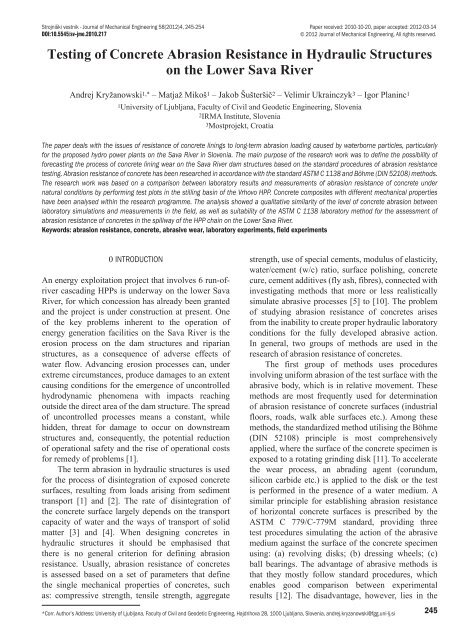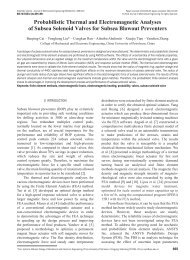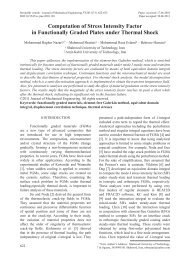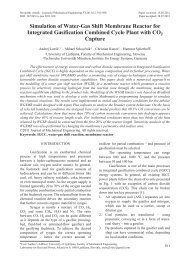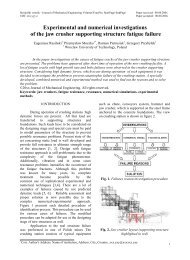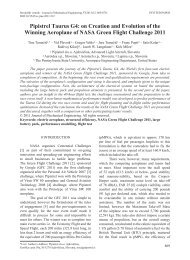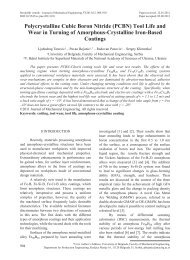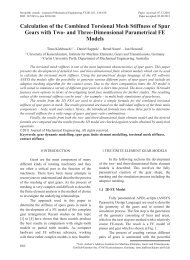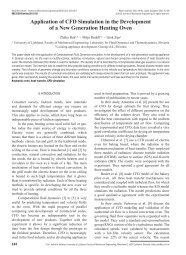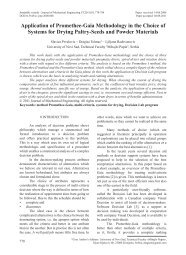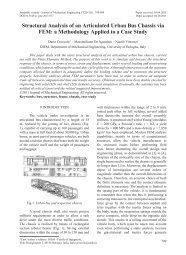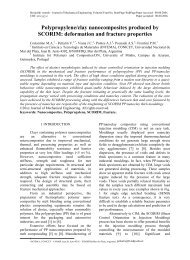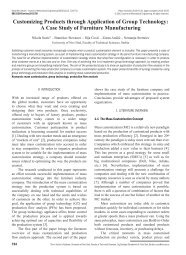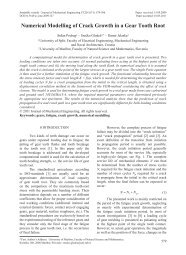Testing of Concrete Abrasion Resistance in Hydraulic Structures on ...
Testing of Concrete Abrasion Resistance in Hydraulic Structures on ...
Testing of Concrete Abrasion Resistance in Hydraulic Structures on ...
You also want an ePaper? Increase the reach of your titles
YUMPU automatically turns print PDFs into web optimized ePapers that Google loves.
Strojniški vestnik - Journal <str<strong>on</strong>g>of</str<strong>on</strong>g> Mechanical Eng<str<strong>on</strong>g>in</str<strong>on</strong>g>eer<str<strong>on</strong>g>in</str<strong>on</strong>g>g 58(2012)4, 245-254 Paper received: 2010-10-20, paper accepted: 2012-03-14<br />
DOI:10.5545/sv-jme.2010.217<br />
© 2012 Journal <str<strong>on</strong>g>of</str<strong>on</strong>g> Mechanical Eng<str<strong>on</strong>g>in</str<strong>on</strong>g>eer<str<strong>on</strong>g>in</str<strong>on</strong>g>g. All rights reserved.<br />
<str<strong>on</strong>g>Test<str<strong>on</strong>g>in</str<strong>on</strong>g>g</str<strong>on</strong>g> <str<strong>on</strong>g>of</str<strong>on</strong>g> <str<strong>on</strong>g>C<strong>on</strong>crete</str<strong>on</strong>g> <str<strong>on</strong>g>Abrasi<strong>on</strong></str<strong>on</strong>g> <str<strong>on</strong>g>Resistance</str<strong>on</strong>g> <str<strong>on</strong>g>in</str<strong>on</strong>g> <str<strong>on</strong>g>Hydraulic</str<strong>on</strong>g> <str<strong>on</strong>g>Structures</str<strong>on</strong>g><br />
<strong>on</strong> the Lower Sava River<br />
Kryžanowski, A. – Mikoš, M. – Šušteršič, J. – Ukra<str<strong>on</strong>g>in</str<strong>on</strong>g>czyk, V. – Plan<str<strong>on</strong>g>in</str<strong>on</strong>g>c, I.<br />
Andrej Kryžanowski 1,* – Matjaž Mikoš 1 – Jakob Šušteršič 2 – Velimir Ukra<str<strong>on</strong>g>in</str<strong>on</strong>g>czyk 3 – Igor Plan<str<strong>on</strong>g>in</str<strong>on</strong>g>c 1<br />
1University <str<strong>on</strong>g>of</str<strong>on</strong>g> Ljubljana, Faculty <str<strong>on</strong>g>of</str<strong>on</strong>g> Civil and Geodetic Eng<str<strong>on</strong>g>in</str<strong>on</strong>g>eer<str<strong>on</strong>g>in</str<strong>on</strong>g>g, Slovenia<br />
2IRMA Institute, Slovenia<br />
3Mostprojekt, Croatia<br />
The paper deals with the issues <str<strong>on</strong>g>of</str<strong>on</strong>g> resistance <str<strong>on</strong>g>of</str<strong>on</strong>g> c<strong>on</strong>crete l<str<strong>on</strong>g>in</str<strong>on</strong>g><str<strong>on</strong>g>in</str<strong>on</strong>g>gs to l<strong>on</strong>g-term abrasi<strong>on</strong> load<str<strong>on</strong>g>in</str<strong>on</strong>g>g caused by waterborne particles, particularly<br />
for the proposed hydro power plants <strong>on</strong> the Sava River <str<strong>on</strong>g>in</str<strong>on</strong>g> Slovenia. The ma<str<strong>on</strong>g>in</str<strong>on</strong>g> purpose <str<strong>on</strong>g>of</str<strong>on</strong>g> the research work was to def<str<strong>on</strong>g>in</str<strong>on</strong>g>e the possibility <str<strong>on</strong>g>of</str<strong>on</strong>g><br />
forecast<str<strong>on</strong>g>in</str<strong>on</strong>g>g the process <str<strong>on</strong>g>of</str<strong>on</strong>g> c<strong>on</strong>crete l<str<strong>on</strong>g>in</str<strong>on</strong>g><str<strong>on</strong>g>in</str<strong>on</strong>g>g wear <strong>on</strong> the Sava River dam structures based <strong>on</strong> the standard procedures <str<strong>on</strong>g>of</str<strong>on</strong>g> abrasi<strong>on</strong> resistance<br />
test<str<strong>on</strong>g>in</str<strong>on</strong>g>g. <str<strong>on</strong>g>Abrasi<strong>on</strong></str<strong>on</strong>g> resistance <str<strong>on</strong>g>of</str<strong>on</strong>g> c<strong>on</strong>crete has been researched <str<strong>on</strong>g>in</str<strong>on</strong>g> accordance with the standard ASTM C 1138 and Böhme (DIN 52108) methods.<br />
The research work was based <strong>on</strong> a comparis<strong>on</strong> between laboratory results and measurements <str<strong>on</strong>g>of</str<strong>on</strong>g> abrasi<strong>on</strong> resistance <str<strong>on</strong>g>of</str<strong>on</strong>g> c<strong>on</strong>crete under<br />
natural c<strong>on</strong>diti<strong>on</strong>s by perform<str<strong>on</strong>g>in</str<strong>on</strong>g>g test plots <str<strong>on</strong>g>in</str<strong>on</strong>g> the still<str<strong>on</strong>g>in</str<strong>on</strong>g>g bas<str<strong>on</strong>g>in</str<strong>on</strong>g> <str<strong>on</strong>g>of</str<strong>on</strong>g> the Vrhovo HPP. <str<strong>on</strong>g>C<strong>on</strong>crete</str<strong>on</strong>g> composites with different mechanical properties<br />
have been analysed with<str<strong>on</strong>g>in</str<strong>on</strong>g> the research programme. The analysis showed a qualitative similarity <str<strong>on</strong>g>of</str<strong>on</strong>g> the level <str<strong>on</strong>g>of</str<strong>on</strong>g> c<strong>on</strong>crete abrasi<strong>on</strong> between<br />
laboratory simulati<strong>on</strong>s and measurements <str<strong>on</strong>g>in</str<strong>on</strong>g> the field, as well as suitability <str<strong>on</strong>g>of</str<strong>on</strong>g> the ASTM C 1138 laboratory method for the assessment <str<strong>on</strong>g>of</str<strong>on</strong>g><br />
abrasi<strong>on</strong> resistance <str<strong>on</strong>g>of</str<strong>on</strong>g> c<strong>on</strong>cretes <str<strong>on</strong>g>in</str<strong>on</strong>g> the spillway <str<strong>on</strong>g>of</str<strong>on</strong>g> the HPP cha<str<strong>on</strong>g>in</str<strong>on</strong>g> <strong>on</strong> the Lower Sava River.<br />
Keywords: abrasi<strong>on</strong> resistance, c<strong>on</strong>crete, abrasive wear, laboratory experiments, field experiments<br />
0 INTRODUCTION<br />
An energy exploitati<strong>on</strong> project that <str<strong>on</strong>g>in</str<strong>on</strong>g>volves 6 run-<str<strong>on</strong>g>of</str<strong>on</strong>g>river<br />
cascad<str<strong>on</strong>g>in</str<strong>on</strong>g>g HPPs is underway <strong>on</strong> the lower Sava<br />
River, for which c<strong>on</strong>cessi<strong>on</strong> has already been granted<br />
and the project is under c<strong>on</strong>structi<strong>on</strong> at present. One<br />
<str<strong>on</strong>g>of</str<strong>on</strong>g> the key problems <str<strong>on</strong>g>in</str<strong>on</strong>g>herent to the operati<strong>on</strong> <str<strong>on</strong>g>of</str<strong>on</strong>g><br />
energy generati<strong>on</strong> facilities <strong>on</strong> the Sava River is the<br />
erosi<strong>on</strong> process <strong>on</strong> the dam structures and riparian<br />
structures, as a c<strong>on</strong>sequence <str<strong>on</strong>g>of</str<strong>on</strong>g> adverse effects <str<strong>on</strong>g>of</str<strong>on</strong>g><br />
water flow. Advanc<str<strong>on</strong>g>in</str<strong>on</strong>g>g erosi<strong>on</strong> processes can, under<br />
extreme circumstances, produce damages to an extent<br />
caus<str<strong>on</strong>g>in</str<strong>on</strong>g>g c<strong>on</strong>diti<strong>on</strong>s for the emergence <str<strong>on</strong>g>of</str<strong>on</strong>g> unc<strong>on</strong>trolled<br />
hydrodynamic phenomena with impacts reach<str<strong>on</strong>g>in</str<strong>on</strong>g>g<br />
outside the direct area <str<strong>on</strong>g>of</str<strong>on</strong>g> the dam structure. The spread<br />
<str<strong>on</strong>g>of</str<strong>on</strong>g> unc<strong>on</strong>trolled processes means a c<strong>on</strong>stant, while<br />
hidden, threat for damage to occur <strong>on</strong> downstream<br />
structures and, c<strong>on</strong>sequently, the potential reducti<strong>on</strong><br />
<str<strong>on</strong>g>of</str<strong>on</strong>g> operati<strong>on</strong>al safety and the rise <str<strong>on</strong>g>of</str<strong>on</strong>g> operati<strong>on</strong>al costs<br />
for remedy <str<strong>on</strong>g>of</str<strong>on</strong>g> problems [1].<br />
The term abrasi<strong>on</strong> <str<strong>on</strong>g>in</str<strong>on</strong>g> hydraulic structures is used<br />
for the process <str<strong>on</strong>g>of</str<strong>on</strong>g> dis<str<strong>on</strong>g>in</str<strong>on</strong>g>tegrati<strong>on</strong> <str<strong>on</strong>g>of</str<strong>on</strong>g> exposed c<strong>on</strong>crete<br />
surfaces, result<str<strong>on</strong>g>in</str<strong>on</strong>g>g from loads aris<str<strong>on</strong>g>in</str<strong>on</strong>g>g from sediment<br />
transport [1] and [2]. The rate <str<strong>on</strong>g>of</str<strong>on</strong>g> dis<str<strong>on</strong>g>in</str<strong>on</strong>g>tegrati<strong>on</strong> <str<strong>on</strong>g>of</str<strong>on</strong>g><br />
the c<strong>on</strong>crete surface largely depends <strong>on</strong> the transport<br />
capacity <str<strong>on</strong>g>of</str<strong>on</strong>g> water and the ways <str<strong>on</strong>g>of</str<strong>on</strong>g> transport <str<strong>on</strong>g>of</str<strong>on</strong>g> solid<br />
matter [3] and [4]. When design<str<strong>on</strong>g>in</str<strong>on</strong>g>g c<strong>on</strong>cretes <str<strong>on</strong>g>in</str<strong>on</strong>g><br />
hydraulic structures it should be emphasised that<br />
there is no general criteri<strong>on</strong> for def<str<strong>on</strong>g>in</str<strong>on</strong>g><str<strong>on</strong>g>in</str<strong>on</strong>g>g abrasi<strong>on</strong><br />
resistance. Usually, abrasi<strong>on</strong> resistance <str<strong>on</strong>g>of</str<strong>on</strong>g> c<strong>on</strong>cretes<br />
is assessed based <strong>on</strong> a set <str<strong>on</strong>g>of</str<strong>on</strong>g> parameters that def<str<strong>on</strong>g>in</str<strong>on</strong>g>e<br />
the s<str<strong>on</strong>g>in</str<strong>on</strong>g>gle mechanical properties <str<strong>on</strong>g>of</str<strong>on</strong>g> c<strong>on</strong>cretes, such<br />
as: compressive strength, tensile strength, aggregate<br />
strength, use <str<strong>on</strong>g>of</str<strong>on</strong>g> special cements, modulus <str<strong>on</strong>g>of</str<strong>on</strong>g> elasticity,<br />
water/cement (w/c) ratio, surface polish<str<strong>on</strong>g>in</str<strong>on</strong>g>g, c<strong>on</strong>crete<br />
cure, cement additives (fly ash, fibres), c<strong>on</strong>nected with<br />
<str<strong>on</strong>g>in</str<strong>on</strong>g>vestigat<str<strong>on</strong>g>in</str<strong>on</strong>g>g methods that more or less realistically<br />
simulate abrasive processes [5] to [10]. The problem<br />
<str<strong>on</strong>g>of</str<strong>on</strong>g> study<str<strong>on</strong>g>in</str<strong>on</strong>g>g abrasi<strong>on</strong> resistance <str<strong>on</strong>g>of</str<strong>on</strong>g> c<strong>on</strong>cretes arises<br />
from the <str<strong>on</strong>g>in</str<strong>on</strong>g>ability to create proper hydraulic laboratory<br />
c<strong>on</strong>diti<strong>on</strong>s for the fully developed abrasive acti<strong>on</strong>.<br />
In general, two groups <str<strong>on</strong>g>of</str<strong>on</strong>g> methods are used <str<strong>on</strong>g>in</str<strong>on</strong>g> the<br />
research <str<strong>on</strong>g>of</str<strong>on</strong>g> abrasi<strong>on</strong> resistance <str<strong>on</strong>g>of</str<strong>on</strong>g> c<strong>on</strong>cretes.<br />
The first group <str<strong>on</strong>g>of</str<strong>on</strong>g> methods uses procedures<br />
<str<strong>on</strong>g>in</str<strong>on</strong>g>volv<str<strong>on</strong>g>in</str<strong>on</strong>g>g uniform abrasi<strong>on</strong> <str<strong>on</strong>g>of</str<strong>on</strong>g> the test surface with the<br />
abrasive body, which is <str<strong>on</strong>g>in</str<strong>on</strong>g> relative movement. These<br />
methods are most frequently used for determ<str<strong>on</strong>g>in</str<strong>on</strong>g>ati<strong>on</strong><br />
<str<strong>on</strong>g>of</str<strong>on</strong>g> abrasi<strong>on</strong> resistance <str<strong>on</strong>g>of</str<strong>on</strong>g> c<strong>on</strong>crete surfaces (<str<strong>on</strong>g>in</str<strong>on</strong>g>dustrial<br />
floors, roads, walk able surfaces etc.). Am<strong>on</strong>g these<br />
methods, the standardized method utilis<str<strong>on</strong>g>in</str<strong>on</strong>g>g the Böhme<br />
(DIN 52108) pr<str<strong>on</strong>g>in</str<strong>on</strong>g>ciple is most comprehensively<br />
applied, where the surface <str<strong>on</strong>g>of</str<strong>on</strong>g> the c<strong>on</strong>crete specimen is<br />
exposed to a rotat<str<strong>on</strong>g>in</str<strong>on</strong>g>g gr<str<strong>on</strong>g>in</str<strong>on</strong>g>d<str<strong>on</strong>g>in</str<strong>on</strong>g>g disk [11]. To accelerate<br />
the wear process, an abrad<str<strong>on</strong>g>in</str<strong>on</strong>g>g agent (corundum,<br />
silic<strong>on</strong> carbide etc.) is applied to the disk or the test<br />
is performed <str<strong>on</strong>g>in</str<strong>on</strong>g> the presence <str<strong>on</strong>g>of</str<strong>on</strong>g> a water medium. A<br />
similar pr<str<strong>on</strong>g>in</str<strong>on</strong>g>ciple for establish<str<strong>on</strong>g>in</str<strong>on</strong>g>g abrasi<strong>on</strong> resistance<br />
<str<strong>on</strong>g>of</str<strong>on</strong>g> horiz<strong>on</strong>tal c<strong>on</strong>crete surfaces is prescribed by the<br />
ASTM C 779/C-779M standard, provid<str<strong>on</strong>g>in</str<strong>on</strong>g>g three<br />
test procedures simulat<str<strong>on</strong>g>in</str<strong>on</strong>g>g the acti<strong>on</strong> <str<strong>on</strong>g>of</str<strong>on</strong>g> the abrasive<br />
medium aga<str<strong>on</strong>g>in</str<strong>on</strong>g>st the surface <str<strong>on</strong>g>of</str<strong>on</strong>g> the c<strong>on</strong>crete specimen<br />
us<str<strong>on</strong>g>in</str<strong>on</strong>g>g: (a) revolv<str<strong>on</strong>g>in</str<strong>on</strong>g>g disks; (b) dress<str<strong>on</strong>g>in</str<strong>on</strong>g>g wheels; (c)<br />
ball bear<str<strong>on</strong>g>in</str<strong>on</strong>g>gs. The advantage <str<strong>on</strong>g>of</str<strong>on</strong>g> abrasive methods is<br />
that they mostly follow standard procedures, which<br />
enables good comparis<strong>on</strong> between experimental<br />
results [12]. The disadvantage, however, lies <str<strong>on</strong>g>in</str<strong>on</strong>g> the<br />
*Corr. Author’s Address: University <str<strong>on</strong>g>of</str<strong>on</strong>g> Ljubljana, Faculty <str<strong>on</strong>g>of</str<strong>on</strong>g> Civil and Geodetic Eng<str<strong>on</strong>g>in</str<strong>on</strong>g>eer<str<strong>on</strong>g>in</str<strong>on</strong>g>g, Hajdrihova 28, 1000 Ljubljana, Slovenia, andrej.kryzanowski@fgg.uni-lj.si 245
Strojniški vestnik - Journal <str<strong>on</strong>g>of</str<strong>on</strong>g> Mechanical Eng<str<strong>on</strong>g>in</str<strong>on</strong>g>eer<str<strong>on</strong>g>in</str<strong>on</strong>g>g 58(2012)4, 245-254<br />
fact that they do not simulate the actual c<strong>on</strong>diti<strong>on</strong>s <str<strong>on</strong>g>of</str<strong>on</strong>g><br />
abrasi<strong>on</strong> <str<strong>on</strong>g>in</str<strong>on</strong>g> hydraulic structures, thus represent<str<strong>on</strong>g>in</str<strong>on</strong>g>g a<br />
limitati<strong>on</strong> to their applicati<strong>on</strong> [1] and [13]. In order to<br />
accelerate the wear process a method with high water<br />
pressure jet was developed [2]. The above menti<strong>on</strong>ed<br />
method simulates cavitati<strong>on</strong> or impact erosi<strong>on</strong> <str<strong>on</strong>g>in</str<strong>on</strong>g><br />
similar manner as <str<strong>on</strong>g>in</str<strong>on</strong>g> [14] and [15].<br />
The sec<strong>on</strong>d group <str<strong>on</strong>g>of</str<strong>on</strong>g> methods that enable the<br />
modell<str<strong>on</strong>g>in</str<strong>on</strong>g>g <str<strong>on</strong>g>of</str<strong>on</strong>g> tribology mechanisms <str<strong>on</strong>g>of</str<strong>on</strong>g> the water<br />
current with bed load come closest to the c<strong>on</strong>diti<strong>on</strong>s<br />
present <str<strong>on</strong>g>in</str<strong>on</strong>g> the natural envir<strong>on</strong>ment [1] and [13]. In<br />
order to test the abrasi<strong>on</strong> resistance <str<strong>on</strong>g>of</str<strong>on</strong>g> c<strong>on</strong>cretes<br />
several methods were developed illustrat<str<strong>on</strong>g>in</str<strong>on</strong>g>g the<br />
acti<strong>on</strong> <str<strong>on</strong>g>of</str<strong>on</strong>g> the water current carry<str<strong>on</strong>g>in</str<strong>on</strong>g>g bed load: Šet<str<strong>on</strong>g>in</str<strong>on</strong>g>a<br />
[16] has studied abrasi<strong>on</strong> resistance <str<strong>on</strong>g>of</str<strong>on</strong>g> c<strong>on</strong>crete<br />
with water current and an abrasive device (siliceous<br />
sand) <str<strong>on</strong>g>in</str<strong>on</strong>g> a circular flume Liu [17] has reported <strong>on</strong> the<br />
development <str<strong>on</strong>g>of</str<strong>on</strong>g> a test method, where the c<strong>on</strong>crete<br />
test specimen is <str<strong>on</strong>g>in</str<strong>on</strong>g> a cyl<str<strong>on</strong>g>in</str<strong>on</strong>g>drical c<strong>on</strong>ta<str<strong>on</strong>g>in</str<strong>on</strong>g>er exposed<br />
to the abrasive acti<strong>on</strong> <str<strong>on</strong>g>of</str<strong>on</strong>g> steel balls. The method was<br />
standardized by the procedure prescribed by ASTM C<br />
1138 [18]. Bania [19] has reported <strong>on</strong> the development<br />
and studies <str<strong>on</strong>g>of</str<strong>on</strong>g> a test method, which is composed <str<strong>on</strong>g>of</str<strong>on</strong>g> a<br />
fixed steel drum, which is partly filled with a mixture<br />
<str<strong>on</strong>g>of</str<strong>on</strong>g> water and aggregate, and a rotat<str<strong>on</strong>g>in</str<strong>on</strong>g>g drive shaft with<br />
fixed tested c<strong>on</strong>crete samples.<br />
Comm<strong>on</strong> to the methods <str<strong>on</strong>g>in</str<strong>on</strong>g>vestigat<str<strong>on</strong>g>in</str<strong>on</strong>g>g abrasi<strong>on</strong><br />
resistance is that they provide <strong>on</strong>ly qualitative<br />
comparis<strong>on</strong>s between the tested specimens, based <strong>on</strong><br />
a proporti<strong>on</strong>al loss <str<strong>on</strong>g>of</str<strong>on</strong>g> mass or <str<strong>on</strong>g>in</str<strong>on</strong>g>put <str<strong>on</strong>g>of</str<strong>on</strong>g> the abrasive<br />
medium dur<str<strong>on</strong>g>in</str<strong>on</strong>g>g the <str<strong>on</strong>g>in</str<strong>on</strong>g>vestigati<strong>on</strong>. The validati<strong>on</strong> <str<strong>on</strong>g>of</str<strong>on</strong>g><br />
results and applicability <str<strong>on</strong>g>of</str<strong>on</strong>g> the methods for forecast<str<strong>on</strong>g>in</str<strong>on</strong>g>g<br />
the behaviour <str<strong>on</strong>g>of</str<strong>on</strong>g> c<strong>on</strong>cretes <str<strong>on</strong>g>in</str<strong>on</strong>g> natural c<strong>on</strong>diti<strong>on</strong>s can<br />
<strong>on</strong>ly be achieved by perform<str<strong>on</strong>g>in</str<strong>on</strong>g>g the test under the<br />
c<strong>on</strong>diti<strong>on</strong>s similar to those <str<strong>on</strong>g>in</str<strong>on</strong>g> the actual operati<strong>on</strong><br />
envir<strong>on</strong>ment <str<strong>on</strong>g>of</str<strong>on</strong>g> the designed structure, <str<strong>on</strong>g>in</str<strong>on</strong>g>clud<str<strong>on</strong>g>in</str<strong>on</strong>g>g the<br />
m<strong>on</strong>itor<str<strong>on</strong>g>in</str<strong>on</strong>g>g <str<strong>on</strong>g>of</str<strong>on</strong>g> all relevant hydraulic and hydrological<br />
parameters [5] and [20]. <str<strong>on</strong>g>Test<str<strong>on</strong>g>in</str<strong>on</strong>g>g</str<strong>on</strong>g> abrasi<strong>on</strong> resistance<br />
<str<strong>on</strong>g>of</str<strong>on</strong>g> specimens under natural circumstances is highly<br />
difficult due to the specific c<strong>on</strong>diti<strong>on</strong>s <str<strong>on</strong>g>of</str<strong>on</strong>g> executi<strong>on</strong><br />
menti<strong>on</strong>ed and the related costs. In the literature, there<br />
has been a s<str<strong>on</strong>g>in</str<strong>on</strong>g>gle case documented, which is that <str<strong>on</strong>g>of</str<strong>on</strong>g><br />
the Runcahez site <str<strong>on</strong>g>in</str<strong>on</strong>g> Switzerland, where the abrasi<strong>on</strong><br />
resistance <str<strong>on</strong>g>of</str<strong>on</strong>g> c<strong>on</strong>cretes was compared follow<str<strong>on</strong>g>in</str<strong>on</strong>g>g the<br />
method proposed by Bania, us<str<strong>on</strong>g>in</str<strong>on</strong>g>g the measurements<br />
<str<strong>on</strong>g>in</str<strong>on</strong>g> the test fields <str<strong>on</strong>g>of</str<strong>on</strong>g> the ma<str<strong>on</strong>g>in</str<strong>on</strong>g> outlet <str<strong>on</strong>g>of</str<strong>on</strong>g> the dam. In the<br />
c<strong>on</strong>clusi<strong>on</strong> <str<strong>on</strong>g>of</str<strong>on</strong>g> the study, a correlati<strong>on</strong> <str<strong>on</strong>g>of</str<strong>on</strong>g> the results <str<strong>on</strong>g>of</str<strong>on</strong>g><br />
measurements <str<strong>on</strong>g>in</str<strong>on</strong>g> the nature with those <str<strong>on</strong>g>in</str<strong>on</strong>g> the laboratory<br />
was established [13]. When study<str<strong>on</strong>g>in</str<strong>on</strong>g>g the adequacy <str<strong>on</strong>g>of</str<strong>on</strong>g><br />
abrasi<strong>on</strong>-resistant c<strong>on</strong>cretes <str<strong>on</strong>g>in</str<strong>on</strong>g> build<str<strong>on</strong>g>in</str<strong>on</strong>g>g the HPP cha<str<strong>on</strong>g>in</str<strong>on</strong>g><br />
<strong>on</strong> the Sava River a similar <str<strong>on</strong>g>in</str<strong>on</strong>g>vestigati<strong>on</strong> was made,<br />
us<str<strong>on</strong>g>in</str<strong>on</strong>g>g test fields <str<strong>on</strong>g>in</str<strong>on</strong>g> the Vrhovo HPP spillway, while the<br />
corresp<strong>on</strong>dence <str<strong>on</strong>g>of</str<strong>on</strong>g> the results was checked aga<str<strong>on</strong>g>in</str<strong>on</strong>g>st the<br />
ASTM C 1138 and Böhme test methods. One <str<strong>on</strong>g>of</str<strong>on</strong>g> the<br />
key goals <str<strong>on</strong>g>of</str<strong>on</strong>g> this study was to establish the possibility<br />
<str<strong>on</strong>g>of</str<strong>on</strong>g> forecast<str<strong>on</strong>g>in</str<strong>on</strong>g>g the development <str<strong>on</strong>g>of</str<strong>on</strong>g> c<strong>on</strong>crete wear <strong>on</strong><br />
the Sava River dam structures based <strong>on</strong> the results<br />
<str<strong>on</strong>g>of</str<strong>on</strong>g> test<str<strong>on</strong>g>in</str<strong>on</strong>g>g abrasi<strong>on</strong> resistance us<str<strong>on</strong>g>in</str<strong>on</strong>g>g the standard<br />
procedures [1].<br />
1 PROBLEM DOMAIN<br />
The Sava river has a typical torrential character with<br />
c<strong>on</strong>siderable hydrological extremes that are reflected<br />
<str<strong>on</strong>g>in</str<strong>on</strong>g> the fluctuati<strong>on</strong> <str<strong>on</strong>g>of</str<strong>on</strong>g> discharge (from 40 to 3,000 m 3 /s)<br />
with highly marked bed-load discharge [21]: the usual<br />
annual bed-load discharge is 66,000 m 3 per year<br />
(mostly limest<strong>on</strong>e), with extremes exceed<str<strong>on</strong>g>in</str<strong>on</strong>g>g 260,000<br />
m 3 per year and suspended load discharge reach<str<strong>on</strong>g>in</str<strong>on</strong>g>g<br />
up to 100,000 m 3 per year. Based <strong>on</strong> sieve analyses<br />
and 20-year observati<strong>on</strong>s <str<strong>on</strong>g>of</str<strong>on</strong>g> sediment transport, the<br />
arithmetic mean gra<str<strong>on</strong>g>in</str<strong>on</strong>g> size diameter is d m = 30.9 mm<br />
and at 90% pass<str<strong>on</strong>g>in</str<strong>on</strong>g>g value d 90 = 72.5 mm. Based <strong>on</strong><br />
the calculated transport capacity <str<strong>on</strong>g>of</str<strong>on</strong>g> the Sava River<br />
after the c<strong>on</strong>structi<strong>on</strong> <str<strong>on</strong>g>of</str<strong>on</strong>g> the Vrhovo HPP, as the first<br />
hydro power plant <str<strong>on</strong>g>in</str<strong>on</strong>g> the cha<str<strong>on</strong>g>in</str<strong>on</strong>g>, it became evident<br />
that the majority <str<strong>on</strong>g>of</str<strong>on</strong>g> the sediment would be reta<str<strong>on</strong>g>in</str<strong>on</strong>g>ed<br />
<str<strong>on</strong>g>in</str<strong>on</strong>g> the reservoir. The wash<str<strong>on</strong>g>in</str<strong>on</strong>g>g <str<strong>on</strong>g>of</str<strong>on</strong>g> the sediment from<br />
the reservoir would become possible <strong>on</strong>ly when the<br />
Sava river flow would exceed 630 m 3 /s. The transport<br />
capacity <str<strong>on</strong>g>of</str<strong>on</strong>g> the river rises proporti<strong>on</strong>ally to its flow<br />
and reaches natural c<strong>on</strong>diti<strong>on</strong>s, prior to the damm<str<strong>on</strong>g>in</str<strong>on</strong>g>g,<br />
at 2,500 m 3 /s, represent<str<strong>on</strong>g>in</str<strong>on</strong>g>g a 20-year return period.<br />
Based <strong>on</strong> the m<strong>on</strong>itor<str<strong>on</strong>g>in</str<strong>on</strong>g>g <str<strong>on</strong>g>of</str<strong>on</strong>g> abrasive acti<strong>on</strong> <str<strong>on</strong>g>in</str<strong>on</strong>g> the<br />
exist<str<strong>on</strong>g>in</str<strong>on</strong>g>g dam structures it can be established that<br />
sediment loaded discharge represents a latent danger<br />
when try<str<strong>on</strong>g>in</str<strong>on</strong>g>g to ensure operati<strong>on</strong> security <str<strong>on</strong>g>of</str<strong>on</strong>g> objects<br />
and functi<strong>on</strong>ality <str<strong>on</strong>g>of</str<strong>on</strong>g> evacuati<strong>on</strong> structures [22].<br />
A typical dam structure <strong>on</strong> the lower Sava<br />
River is composed <str<strong>on</strong>g>of</str<strong>on</strong>g> a powerhouse and 5 spillways,<br />
transversal to the river flow. Each spillway is equipped<br />
with a segmental gate with a flap. To the level <str<strong>on</strong>g>of</str<strong>on</strong>g> the<br />
<str<strong>on</strong>g>in</str<strong>on</strong>g>stalled discharge Q = 500 m 3 /s HPP operates <str<strong>on</strong>g>in</str<strong>on</strong>g> the<br />
run-<str<strong>on</strong>g>of</str<strong>on</strong>g>-river flow regime, and the evacuati<strong>on</strong> <str<strong>on</strong>g>of</str<strong>on</strong>g> flood<br />
water is through flap gates (up to 365 m 3 /s <strong>on</strong> Vrhovo<br />
HPP) or by outflow under the segmental gate. Under<br />
normal operat<str<strong>on</strong>g>in</str<strong>on</strong>g>g c<strong>on</strong>diti<strong>on</strong>s, based <strong>on</strong> the calculated<br />
transport capacity <str<strong>on</strong>g>of</str<strong>on</strong>g> the Sava river <strong>on</strong> the evacuati<strong>on</strong><br />
structures <str<strong>on</strong>g>of</str<strong>on</strong>g> the dams, the flow <str<strong>on</strong>g>of</str<strong>on</strong>g> sediment <str<strong>on</strong>g>in</str<strong>on</strong>g> the<br />
form <str<strong>on</strong>g>of</str<strong>on</strong>g> suspensi<strong>on</strong> or bed load with a gra<str<strong>on</strong>g>in</str<strong>on</strong>g> diameter<br />
<str<strong>on</strong>g>of</str<strong>on</strong>g> d = 1 mm or less is expected. Dur<str<strong>on</strong>g>in</str<strong>on</strong>g>g extreme flow<br />
<str<strong>on</strong>g>of</str<strong>on</strong>g> the Sava River when the discharge exceeds 1,200<br />
m 3 /s, the natural flow regime is established through<br />
the underspill below the gates and de-levell<str<strong>on</strong>g>in</str<strong>on</strong>g>g <str<strong>on</strong>g>of</str<strong>on</strong>g><br />
the water level. The natural flow regime through<br />
the dam secti<strong>on</strong> is achieved by full open<str<strong>on</strong>g>in</str<strong>on</strong>g>g <str<strong>on</strong>g>of</str<strong>on</strong>g> the<br />
246 Kryžanowski, A. – Mikoš, M. – Šušteršič, J. – Ukra<str<strong>on</strong>g>in</str<strong>on</strong>g>czyk, V. – Plan<str<strong>on</strong>g>in</str<strong>on</strong>g>c, I.
Strojniški vestnik - Journal <str<strong>on</strong>g>of</str<strong>on</strong>g> Mechanical Eng<str<strong>on</strong>g>in</str<strong>on</strong>g>eer<str<strong>on</strong>g>in</str<strong>on</strong>g>g 58(2012)4, 245-254<br />
gates, which is achieved at 2,500 m 3 /s. Under such<br />
c<strong>on</strong>diti<strong>on</strong>s the transport <str<strong>on</strong>g>of</str<strong>on</strong>g> coarse gra<str<strong>on</strong>g>in</str<strong>on</strong>g>s is expected.<br />
Because <str<strong>on</strong>g>of</str<strong>on</strong>g> such operati<strong>on</strong> regime, the exposed parts<br />
<str<strong>on</strong>g>of</str<strong>on</strong>g> spillways, where abrasive erosi<strong>on</strong> is to be expected,<br />
are covered with abrasi<strong>on</strong>-resistant c<strong>on</strong>crete l<str<strong>on</strong>g>in</str<strong>on</strong>g><str<strong>on</strong>g>in</str<strong>on</strong>g>g<br />
[5] and [22]. In design<str<strong>on</strong>g>in</str<strong>on</strong>g>g abrasi<strong>on</strong> resistant c<strong>on</strong>cretes<br />
it was necessary to solve a number <str<strong>on</strong>g>of</str<strong>on</strong>g> questi<strong>on</strong>s<br />
related to the proper c<strong>on</strong>crete compositi<strong>on</strong> to be able<br />
to determ<str<strong>on</strong>g>in</str<strong>on</strong>g>e the appropriate research methods, the<br />
applicati<strong>on</strong> <str<strong>on</strong>g>in</str<strong>on</strong>g> the field and, last but not least, to check<br />
the material resistance dur<str<strong>on</strong>g>in</str<strong>on</strong>g>g the exploitati<strong>on</strong>. As part<br />
<str<strong>on</strong>g>of</str<strong>on</strong>g> <str<strong>on</strong>g>in</str<strong>on</strong>g>terventi<strong>on</strong>/remedial measures <strong>on</strong> the spillways<br />
<str<strong>on</strong>g>of</str<strong>on</strong>g> the Vrhovo HPP the possibility <str<strong>on</strong>g>of</str<strong>on</strong>g> perform<str<strong>on</strong>g>in</str<strong>on</strong>g>g a<br />
research project was provided, study<str<strong>on</strong>g>in</str<strong>on</strong>g>g the adequacy<br />
<str<strong>on</strong>g>of</str<strong>on</strong>g> technologies produc<str<strong>on</strong>g>in</str<strong>on</strong>g>g abrasi<strong>on</strong> resistant c<strong>on</strong>crete<br />
l<str<strong>on</strong>g>in</str<strong>on</strong>g><str<strong>on</strong>g>in</str<strong>on</strong>g>gs and the methods for test<str<strong>on</strong>g>in</str<strong>on</strong>g>g abrasi<strong>on</strong> resistance<br />
<str<strong>on</strong>g>of</str<strong>on</strong>g> materials. The research project enabled the<br />
<str<strong>on</strong>g>in</str<strong>on</strong>g>troducti<strong>on</strong> <str<strong>on</strong>g>of</str<strong>on</strong>g> test plots <str<strong>on</strong>g>in</str<strong>on</strong>g> natural c<strong>on</strong>diti<strong>on</strong>s try<str<strong>on</strong>g>in</str<strong>on</strong>g>g<br />
to realize, am<strong>on</strong>g others, the follow<str<strong>on</strong>g>in</str<strong>on</strong>g>g goals [1]:<br />
(i) To enable quantificati<strong>on</strong> <str<strong>on</strong>g>of</str<strong>on</strong>g> results <str<strong>on</strong>g>of</str<strong>on</strong>g> the<br />
laboratory method <str<strong>on</strong>g>in</str<strong>on</strong>g>vestigat<str<strong>on</strong>g>in</str<strong>on</strong>g>g abrasi<strong>on</strong><br />
resistance compared to measurements <str<strong>on</strong>g>in</str<strong>on</strong>g> the<br />
natural envir<strong>on</strong>ment.<br />
(ii) To enable forecast<str<strong>on</strong>g>in</str<strong>on</strong>g>g <str<strong>on</strong>g>of</str<strong>on</strong>g> behaviour <str<strong>on</strong>g>of</str<strong>on</strong>g> material<br />
dur<str<strong>on</strong>g>in</str<strong>on</strong>g>g exploitati<strong>on</strong>.<br />
2 ABRASION EROSION<br />
The general tribological structure <str<strong>on</strong>g>of</str<strong>on</strong>g> wear <str<strong>on</strong>g>of</str<strong>on</strong>g> c<strong>on</strong>crete<br />
surfaces <str<strong>on</strong>g>in</str<strong>on</strong>g> hydraulic structures can be described<br />
as follows: (i) the basic body be<str<strong>on</strong>g>in</str<strong>on</strong>g>g moti<strong>on</strong>less, is<br />
the c<strong>on</strong>crete surface <str<strong>on</strong>g>of</str<strong>on</strong>g> the c<strong>on</strong>structi<strong>on</strong>, and (ii)<br />
the body act<str<strong>on</strong>g>in</str<strong>on</strong>g>g up<strong>on</strong> the c<strong>on</strong>crete surface, be<str<strong>on</strong>g>in</str<strong>on</strong>g>g <str<strong>on</strong>g>in</str<strong>on</strong>g><br />
moti<strong>on</strong>, is represented by the water current runn<str<strong>on</strong>g>in</str<strong>on</strong>g>g<br />
past the c<strong>on</strong>crete surface. The term abrasi<strong>on</strong> erosi<strong>on</strong><br />
<str<strong>on</strong>g>in</str<strong>on</strong>g> hydraulic structures is used to describe the wear <str<strong>on</strong>g>of</str<strong>on</strong>g><br />
the solid surface be<str<strong>on</strong>g>in</str<strong>on</strong>g>g the result <str<strong>on</strong>g>of</str<strong>on</strong>g> acti<strong>on</strong> <str<strong>on</strong>g>of</str<strong>on</strong>g> the water<br />
current past the surface with associated hydrodynamic<br />
phenomena and solid particles (sediment) transported<br />
with the water current. The emergence <str<strong>on</strong>g>of</str<strong>on</strong>g> abrasive<br />
erosi<strong>on</strong> <strong>on</strong> c<strong>on</strong>crete surfaces <str<strong>on</strong>g>of</str<strong>on</strong>g> hydraulic structures<br />
can be caused by acti<strong>on</strong> <str<strong>on</strong>g>of</str<strong>on</strong>g> deteriorati<strong>on</strong> processes<br />
(abrasi<strong>on</strong>) due to:<br />
• fricti<strong>on</strong> forces dur<str<strong>on</strong>g>in</str<strong>on</strong>g>g slid<str<strong>on</strong>g>in</str<strong>on</strong>g>g and roll<str<strong>on</strong>g>in</str<strong>on</strong>g>g <str<strong>on</strong>g>of</str<strong>on</strong>g><br />
sediment gra<str<strong>on</strong>g>in</str<strong>on</strong>g>s transported by the water current<br />
<str<strong>on</strong>g>in</str<strong>on</strong>g> c<strong>on</strong>tact with the c<strong>on</strong>crete surfaces,<br />
• impact forces <str<strong>on</strong>g>of</str<strong>on</strong>g> sediment gra<str<strong>on</strong>g>in</str<strong>on</strong>g>s transported by<br />
the water current up<strong>on</strong> impact with the c<strong>on</strong>crete<br />
surface and pressure pulsati<strong>on</strong>s <str<strong>on</strong>g>in</str<strong>on</strong>g> the surround<str<strong>on</strong>g>in</str<strong>on</strong>g>g<br />
water body.<br />
Accord<str<strong>on</strong>g>in</str<strong>on</strong>g>gly, the abrasi<strong>on</strong> erosi<strong>on</strong> <str<strong>on</strong>g>of</str<strong>on</strong>g> c<strong>on</strong>crete can<br />
be divided <str<strong>on</strong>g>in</str<strong>on</strong>g>to several phases. In the <str<strong>on</strong>g>in</str<strong>on</strong>g>itial phase, the<br />
process <str<strong>on</strong>g>of</str<strong>on</strong>g> abrasi<strong>on</strong> is caused by sediment transport.<br />
The damage to c<strong>on</strong>crete structures thus results from<br />
polish<str<strong>on</strong>g>in</str<strong>on</strong>g>g/mill<str<strong>on</strong>g>in</str<strong>on</strong>g>g due to roll<str<strong>on</strong>g>in</str<strong>on</strong>g>g or slid<str<strong>on</strong>g>in</str<strong>on</strong>g>g <str<strong>on</strong>g>of</str<strong>on</strong>g> sediments<br />
(solid particles) aga<str<strong>on</strong>g>in</str<strong>on</strong>g>st the surface. By <str<strong>on</strong>g>in</str<strong>on</strong>g>creased<br />
transport capacity, the small particles start to move <str<strong>on</strong>g>in</str<strong>on</strong>g><br />
suspensi<strong>on</strong>, and large solid particles move by way <str<strong>on</strong>g>of</str<strong>on</strong>g><br />
bounc<str<strong>on</strong>g>in</str<strong>on</strong>g>g. In this phase, the abrasi<strong>on</strong> process depends<br />
<strong>on</strong> bed load transport or suspended matter. In additi<strong>on</strong><br />
to the gr<str<strong>on</strong>g>in</str<strong>on</strong>g>d<str<strong>on</strong>g>in</str<strong>on</strong>g>g acti<strong>on</strong> aga<str<strong>on</strong>g>in</str<strong>on</strong>g>st c<strong>on</strong>crete surfaces,<br />
damage due to impacts <str<strong>on</strong>g>of</str<strong>on</strong>g> solid particles aga<str<strong>on</strong>g>in</str<strong>on</strong>g>st the<br />
surface may be observed. By <str<strong>on</strong>g>in</str<strong>on</strong>g>creased transport<br />
capacity the size and quantity <str<strong>on</strong>g>of</str<strong>on</strong>g> bounc<str<strong>on</strong>g>in</str<strong>on</strong>g>g particles<br />
<str<strong>on</strong>g>in</str<strong>on</strong>g>crease significantly, and, simultaneously, pressure<br />
pulsati<strong>on</strong>s <str<strong>on</strong>g>in</str<strong>on</strong>g> the water <str<strong>on</strong>g>in</str<strong>on</strong>g>crease. This c<strong>on</strong>tributes to<br />
the <str<strong>on</strong>g>in</str<strong>on</strong>g>tensity <str<strong>on</strong>g>of</str<strong>on</strong>g> the abrasi<strong>on</strong> process. The emerg<str<strong>on</strong>g>in</str<strong>on</strong>g>g<br />
damages <strong>on</strong> c<strong>on</strong>crete surfaces are related to the<br />
<str<strong>on</strong>g>in</str<strong>on</strong>g>crease <str<strong>on</strong>g>of</str<strong>on</strong>g> the size <str<strong>on</strong>g>of</str<strong>on</strong>g> solid particles and the <str<strong>on</strong>g>in</str<strong>on</strong>g>tensity<br />
<str<strong>on</strong>g>of</str<strong>on</strong>g> impacts aga<str<strong>on</strong>g>in</str<strong>on</strong>g>st the bottom, where at first <str<strong>on</strong>g>in</str<strong>on</strong>g>itial<br />
damages occur, which represent, with progress<str<strong>on</strong>g>in</str<strong>on</strong>g>g<br />
processes, the core <str<strong>on</strong>g>of</str<strong>on</strong>g> progressive spread<str<strong>on</strong>g>in</str<strong>on</strong>g>g <str<strong>on</strong>g>of</str<strong>on</strong>g> the<br />
damage <str<strong>on</strong>g>in</str<strong>on</strong>g> the directi<strong>on</strong> <str<strong>on</strong>g>of</str<strong>on</strong>g> the water current [4] and<br />
[20].<br />
Damages to c<strong>on</strong>crete surfaces are the result<br />
<str<strong>on</strong>g>of</str<strong>on</strong>g> hydrodynamic processes <str<strong>on</strong>g>of</str<strong>on</strong>g> the water flow and<br />
abrasive acti<strong>on</strong> caused by waterborne particles strik<str<strong>on</strong>g>in</str<strong>on</strong>g>g<br />
aga<str<strong>on</strong>g>in</str<strong>on</strong>g>st the base. The impacts <str<strong>on</strong>g>of</str<strong>on</strong>g> the water flow <str<strong>on</strong>g>in</str<strong>on</strong>g> the<br />
process <str<strong>on</strong>g>of</str<strong>on</strong>g> failure can be expressed by shear stresses<br />
act<str<strong>on</strong>g>in</str<strong>on</strong>g>g <strong>on</strong> the surface as a c<strong>on</strong>sequence <str<strong>on</strong>g>of</str<strong>on</strong>g> water acti<strong>on</strong>,<br />
normal stresses, and pressure with<str<strong>on</strong>g>in</str<strong>on</strong>g> the body <str<strong>on</strong>g>of</str<strong>on</strong>g> the<br />
hydro structure. Waterborne particles act aga<str<strong>on</strong>g>in</str<strong>on</strong>g>st the<br />
surface due to their characteristic movement: rotati<strong>on</strong>,<br />
translati<strong>on</strong>al moti<strong>on</strong>s, saltati<strong>on</strong>, or a comb<str<strong>on</strong>g>in</str<strong>on</strong>g>ati<strong>on</strong> <str<strong>on</strong>g>of</str<strong>on</strong>g><br />
these. Abrasive acti<strong>on</strong> <str<strong>on</strong>g>of</str<strong>on</strong>g> waterborne particles causes<br />
the development <str<strong>on</strong>g>of</str<strong>on</strong>g> f<str<strong>on</strong>g>in</str<strong>on</strong>g>e cracks <strong>on</strong> the surface and<br />
with<str<strong>on</strong>g>in</str<strong>on</strong>g> the c<strong>on</strong>crete structure. The cracks develop due<br />
to the exceeded limited tensile stresses <str<strong>on</strong>g>in</str<strong>on</strong>g> c<strong>on</strong>crete.<br />
Tensile and compressive forces accelerate the<br />
development <str<strong>on</strong>g>of</str<strong>on</strong>g> cracks, weaken the structure (material<br />
fatigue strength) and destroy the <str<strong>on</strong>g>in</str<strong>on</strong>g>ternal b<strong>on</strong>ds <str<strong>on</strong>g>in</str<strong>on</strong>g> the<br />
structure, while the water flow starts to wash away<br />
the particles <str<strong>on</strong>g>of</str<strong>on</strong>g> cement b<str<strong>on</strong>g>in</str<strong>on</strong>g>der and aggregate. The<br />
degradati<strong>on</strong> process c<strong>on</strong>t<str<strong>on</strong>g>in</str<strong>on</strong>g>ues <str<strong>on</strong>g>in</str<strong>on</strong>g> the <str<strong>on</strong>g>in</str<strong>on</strong>g>terior <str<strong>on</strong>g>of</str<strong>on</strong>g> the<br />
structure reveal<str<strong>on</strong>g>in</str<strong>on</strong>g>g visible damages. The deteriorati<strong>on</strong><br />
process is even faster <str<strong>on</strong>g>in</str<strong>on</strong>g> turbulent waters due to the<br />
dynamic phenomena (pressure pulsati<strong>on</strong>, vibrati<strong>on</strong>s <str<strong>on</strong>g>in</str<strong>on</strong>g><br />
the structure and strokes <str<strong>on</strong>g>of</str<strong>on</strong>g> particulate matter aga<str<strong>on</strong>g>in</str<strong>on</strong>g>st<br />
the foundati<strong>on</strong>). The failure <str<strong>on</strong>g>of</str<strong>on</strong>g> c<strong>on</strong>crete structure<br />
occurs both <str<strong>on</strong>g>in</str<strong>on</strong>g> the cement and <str<strong>on</strong>g>in</str<strong>on</strong>g> the aggregate, mostly<br />
al<strong>on</strong>g the <str<strong>on</strong>g>in</str<strong>on</strong>g>terface between the cement b<str<strong>on</strong>g>in</str<strong>on</strong>g>der and the<br />
aggregate, where repeated dynamic processes widen<br />
the <str<strong>on</strong>g>in</str<strong>on</strong>g>itial cracks and weaken the c<strong>on</strong>tact. The damages<br />
caused by the abrasive water acti<strong>on</strong> are characterized<br />
by roughness, irregularly corroded surface with<br />
hollows and swell<str<strong>on</strong>g>in</str<strong>on</strong>g>gs <str<strong>on</strong>g>in</str<strong>on</strong>g> the basic structure. <str<strong>on</strong>g>Abrasi<strong>on</strong></str<strong>on</strong>g><br />
<str<strong>on</strong>g>Test<str<strong>on</strong>g>in</str<strong>on</strong>g>g</str<strong>on</strong>g> <str<strong>on</strong>g>of</str<strong>on</strong>g> <str<strong>on</strong>g>C<strong>on</strong>crete</str<strong>on</strong>g> <str<strong>on</strong>g>Abrasi<strong>on</strong></str<strong>on</strong>g> <str<strong>on</strong>g>Resistance</str<strong>on</strong>g> <str<strong>on</strong>g>in</str<strong>on</strong>g> <str<strong>on</strong>g>Hydraulic</str<strong>on</strong>g> <str<strong>on</strong>g>Structures</str<strong>on</strong>g> <strong>on</strong> the Lower Sava River<br />
247
Strojniški vestnik - Journal <str<strong>on</strong>g>of</str<strong>on</strong>g> Mechanical Eng<str<strong>on</strong>g>in</str<strong>on</strong>g>eer<str<strong>on</strong>g>in</str<strong>on</strong>g>g 58(2012)4, 245-254<br />
erosi<strong>on</strong> <strong>on</strong> hydro structures typically occur <strong>on</strong> exposed<br />
parts <str<strong>on</strong>g>of</str<strong>on</strong>g> evacuati<strong>on</strong> structures, such as: spillways,<br />
outlet channels, by-pass channels, still<str<strong>on</strong>g>in</str<strong>on</strong>g>g bas<str<strong>on</strong>g>in</str<strong>on</strong>g>s,<br />
dra<str<strong>on</strong>g>in</str<strong>on</strong>g>age outfalls and culverts [20].<br />
A number <str<strong>on</strong>g>of</str<strong>on</strong>g> experimental methods which more<br />
or less realistically illustrate the abrasi<strong>on</strong> process are<br />
used <str<strong>on</strong>g>in</str<strong>on</strong>g> practice. The purpose <str<strong>on</strong>g>of</str<strong>on</strong>g> all test methods is to<br />
obta<str<strong>on</strong>g>in</str<strong>on</strong>g> the relevant parameters with<str<strong>on</strong>g>in</str<strong>on</strong>g> the real time to<br />
assess the quality <str<strong>on</strong>g>of</str<strong>on</strong>g> the material. C<strong>on</strong>siderati<strong>on</strong> is to<br />
be given to the fact that due to the complex problem<br />
solv<str<strong>on</strong>g>in</str<strong>on</strong>g>g, <strong>on</strong>ly a comparative evaluati<strong>on</strong> <str<strong>on</strong>g>of</str<strong>on</strong>g> the results<br />
is possible. Therefore, it is reas<strong>on</strong>able to use such an<br />
experimental method that will give the real data <str<strong>on</strong>g>in</str<strong>on</strong>g><br />
a short period <str<strong>on</strong>g>of</str<strong>on</strong>g> time and enable comparis<strong>on</strong> <str<strong>on</strong>g>of</str<strong>on</strong>g> the<br />
results with the results obta<str<strong>on</strong>g>in</str<strong>on</strong>g>ed from other sources at<br />
the same time. When choos<str<strong>on</strong>g>in</str<strong>on</strong>g>g an adequate method<br />
the follow<str<strong>on</strong>g>in</str<strong>on</strong>g>g start<str<strong>on</strong>g>in</str<strong>on</strong>g>g po<str<strong>on</strong>g>in</str<strong>on</strong>g>ts were c<strong>on</strong>sidered:<br />
• The method <str<strong>on</strong>g>of</str<strong>on</strong>g> test<str<strong>on</strong>g>in</str<strong>on</strong>g>g abrasi<strong>on</strong> resistance must<br />
illustrate the expected c<strong>on</strong>diti<strong>on</strong>s <str<strong>on</strong>g>of</str<strong>on</strong>g> transport <str<strong>on</strong>g>of</str<strong>on</strong>g><br />
bed load and suspensi<strong>on</strong> al<strong>on</strong>g the evacuati<strong>on</strong><br />
structures <strong>on</strong> the hydro structures <str<strong>on</strong>g>of</str<strong>on</strong>g> the Sava<br />
river as faithfully as possible.<br />
• The test<str<strong>on</strong>g>in</str<strong>on</strong>g>g procedure <str<strong>on</strong>g>of</str<strong>on</strong>g> abrasi<strong>on</strong> resistance must<br />
be standardised, thus provid<str<strong>on</strong>g>in</str<strong>on</strong>g>g the repeatability<br />
<str<strong>on</strong>g>of</str<strong>on</strong>g> the test and the possibility <str<strong>on</strong>g>of</str<strong>on</strong>g> comparis<strong>on</strong> <str<strong>on</strong>g>of</str<strong>on</strong>g><br />
the results <str<strong>on</strong>g>of</str<strong>on</strong>g> measurements with those from the<br />
literature.<br />
• The performance <str<strong>on</strong>g>of</str<strong>on</strong>g> the test must be ec<strong>on</strong>omical<br />
– the purchase <str<strong>on</strong>g>of</str<strong>on</strong>g> test<str<strong>on</strong>g>in</str<strong>on</strong>g>g equipment and the<br />
durati<strong>on</strong> <str<strong>on</strong>g>of</str<strong>on</strong>g> the test are <str<strong>on</strong>g>of</str<strong>on</strong>g> significance, which<br />
must be comparable to the standard methods for<br />
test<str<strong>on</strong>g>in</str<strong>on</strong>g>g the quality <str<strong>on</strong>g>of</str<strong>on</strong>g> hardened c<strong>on</strong>crete.<br />
• To ensure the comparability <str<strong>on</strong>g>of</str<strong>on</strong>g> results <str<strong>on</strong>g>of</str<strong>on</strong>g><br />
measurements those methods test<str<strong>on</strong>g>in</str<strong>on</strong>g>g abrasi<strong>on</strong><br />
resistance that have already been used for the<br />
dem<strong>on</strong>strati<strong>on</strong> <str<strong>on</strong>g>of</str<strong>on</strong>g> quality <str<strong>on</strong>g>of</str<strong>on</strong>g> build<str<strong>on</strong>g>in</str<strong>on</strong>g>g the Lower<br />
Sava river HPPs need to be <str<strong>on</strong>g>in</str<strong>on</strong>g>cluded.<br />
These start<str<strong>on</strong>g>in</str<strong>on</strong>g>g po<str<strong>on</strong>g>in</str<strong>on</strong>g>ts provided the grounds for<br />
choos<str<strong>on</strong>g>in</str<strong>on</strong>g>g two standard methods for test<str<strong>on</strong>g>in</str<strong>on</strong>g>g abrasi<strong>on</strong><br />
resistance <str<strong>on</strong>g>in</str<strong>on</strong>g> our research.<br />
2.1 The Gr<str<strong>on</strong>g>in</str<strong>on</strong>g>d<str<strong>on</strong>g>in</str<strong>on</strong>g>g Method after Böhme<br />
The test <str<strong>on</strong>g>of</str<strong>on</strong>g> resistance <str<strong>on</strong>g>of</str<strong>on</strong>g> c<strong>on</strong>crete specimens to<br />
gr<str<strong>on</strong>g>in</str<strong>on</strong>g>d<str<strong>on</strong>g>in</str<strong>on</strong>g>g was performed follow<str<strong>on</strong>g>in</str<strong>on</strong>g>g the procedure<br />
prescribed by standard DIN 52108. The test was<br />
performed <strong>on</strong> standard specimens (cubes with 7.1-<br />
cm sides) at 90-day age, us<str<strong>on</strong>g>in</str<strong>on</strong>g>g three samples per<br />
compositi<strong>on</strong>. The specimen was clamped and fixed<br />
to the mount<str<strong>on</strong>g>in</str<strong>on</strong>g>g hold<str<strong>on</strong>g>in</str<strong>on</strong>g>g it aga<str<strong>on</strong>g>in</str<strong>on</strong>g>st a rotat<str<strong>on</strong>g>in</str<strong>on</strong>g>g gr<str<strong>on</strong>g>in</str<strong>on</strong>g>d<str<strong>on</strong>g>in</str<strong>on</strong>g>g<br />
disk that provided a uniform gr<str<strong>on</strong>g>in</str<strong>on</strong>g>d<str<strong>on</strong>g>in</str<strong>on</strong>g>g <str<strong>on</strong>g>of</str<strong>on</strong>g> its surface.<br />
The specimen was weighed before the test and then<br />
each time after a set <str<strong>on</strong>g>of</str<strong>on</strong>g> 4 cycles (<strong>on</strong>e cycle c<strong>on</strong>sisted <str<strong>on</strong>g>of</str<strong>on</strong>g><br />
22 revoluti<strong>on</strong>s <str<strong>on</strong>g>of</str<strong>on</strong>g> the gr<str<strong>on</strong>g>in</str<strong>on</strong>g>d<str<strong>on</strong>g>in</str<strong>on</strong>g>g disk) at 0.1 g accuracy.<br />
An abrad<str<strong>on</strong>g>in</str<strong>on</strong>g>g agent (corundum, quartz sand etc.) can be<br />
applied, <str<strong>on</strong>g>in</str<strong>on</strong>g> dry or wet state, thus accelerat<str<strong>on</strong>g>in</str<strong>on</strong>g>g the rate<br />
<str<strong>on</strong>g>of</str<strong>on</strong>g> deteriorati<strong>on</strong>. The prevail<str<strong>on</strong>g>in</str<strong>on</strong>g>g deteriorati<strong>on</strong> process<br />
is abrasi<strong>on</strong> through gr<str<strong>on</strong>g>in</str<strong>on</strong>g>d<str<strong>on</strong>g>in</str<strong>on</strong>g>g; typically occurr<str<strong>on</strong>g>in</str<strong>on</strong>g>g<br />
<str<strong>on</strong>g>in</str<strong>on</strong>g> roads, walk able surfaces etc. The result <str<strong>on</strong>g>of</str<strong>on</strong>g> the<br />
test is the wear <str<strong>on</strong>g>of</str<strong>on</strong>g> c<strong>on</strong>crete after 16 cycles, which is<br />
determ<str<strong>on</strong>g>in</str<strong>on</strong>g>ed by the loss <str<strong>on</strong>g>of</str<strong>on</strong>g> volume <str<strong>on</strong>g>of</str<strong>on</strong>g> the specimen <str<strong>on</strong>g>in</str<strong>on</strong>g><br />
cm 3 <str<strong>on</strong>g>in</str<strong>on</strong>g> an area <str<strong>on</strong>g>of</str<strong>on</strong>g> 50 cm 2 .<br />
Indeed, the method does not simulate the real<br />
c<strong>on</strong>diti<strong>on</strong>s <str<strong>on</strong>g>of</str<strong>on</strong>g> the abrasi<strong>on</strong> process <strong>on</strong> hydraulic<br />
structures, but its applicability lies <str<strong>on</strong>g>in</str<strong>on</strong>g> the fact that this<br />
is a standardised procedure that is generally used <str<strong>on</strong>g>in</str<strong>on</strong>g><br />
the research <str<strong>on</strong>g>of</str<strong>on</strong>g> abrasi<strong>on</strong> resistance. Until recently, the<br />
dem<strong>on</strong>strati<strong>on</strong> <str<strong>on</strong>g>of</str<strong>on</strong>g> abrasi<strong>on</strong> resistance to gr<str<strong>on</strong>g>in</str<strong>on</strong>g>d<str<strong>on</strong>g>in</str<strong>on</strong>g>g after<br />
Böhme <str<strong>on</strong>g>in</str<strong>on</strong>g> Slovenia had been the <strong>on</strong>ly standardised<br />
method <str<strong>on</strong>g>of</str<strong>on</strong>g> test<str<strong>on</strong>g>in</str<strong>on</strong>g>g abrasi<strong>on</strong> resistance and therefore the<br />
<strong>on</strong>ly possible qualitative comparis<strong>on</strong> with the results<br />
<str<strong>on</strong>g>of</str<strong>on</strong>g> measurements <str<strong>on</strong>g>of</str<strong>on</strong>g> abrasi<strong>on</strong> resistance performed<br />
<str<strong>on</strong>g>in</str<strong>on</strong>g> the past. Based <strong>on</strong> the comparative analysis the<br />
quality class <str<strong>on</strong>g>of</str<strong>on</strong>g> the tested samples can be predicted<br />
and therewith the start<str<strong>on</strong>g>in</str<strong>on</strong>g>g po<str<strong>on</strong>g>in</str<strong>on</strong>g>ts for qualitative<br />
comparis<strong>on</strong>s <str<strong>on</strong>g>of</str<strong>on</strong>g> results <str<strong>on</strong>g>of</str<strong>on</strong>g> abrasi<strong>on</strong> resistance <str<strong>on</strong>g>of</str<strong>on</strong>g><br />
c<strong>on</strong>cretes with other chosen test methods.<br />
2.2 Abrasive Erosi<strong>on</strong> Method after ASTM C1138<br />
The abrasi<strong>on</strong> resistance test was performed <str<strong>on</strong>g>in</str<strong>on</strong>g><br />
accordance with standard ASTM C 1138 method<br />
at 90- and 900-day ages, <strong>on</strong> cyl<str<strong>on</strong>g>in</str<strong>on</strong>g>ders <str<strong>on</strong>g>of</str<strong>on</strong>g> Ø30/10<br />
cm, tak<str<strong>on</strong>g>in</str<strong>on</strong>g>g <strong>on</strong>e sample per compositi<strong>on</strong>. The test<br />
method is designed to duplicate the abrasive acti<strong>on</strong> <str<strong>on</strong>g>of</str<strong>on</strong>g><br />
waterborne particles <str<strong>on</strong>g>in</str<strong>on</strong>g> the still<str<strong>on</strong>g>in</str<strong>on</strong>g>g bas<str<strong>on</strong>g>in</str<strong>on</strong>g>s. Circulat<str<strong>on</strong>g>in</str<strong>on</strong>g>g<br />
water moves the steel gr<str<strong>on</strong>g>in</str<strong>on</strong>g>d<str<strong>on</strong>g>in</str<strong>on</strong>g>g balls <strong>on</strong> the surface<br />
<str<strong>on</strong>g>of</str<strong>on</strong>g> a c<strong>on</strong>crete sample, produc<str<strong>on</strong>g>in</str<strong>on</strong>g>g the desired abrasi<strong>on</strong><br />
effects. The water velocity and agitati<strong>on</strong> effect are<br />
not sufficient to lift the steel balls <str<strong>on</strong>g>of</str<strong>on</strong>g>f the surface <str<strong>on</strong>g>of</str<strong>on</strong>g><br />
the c<strong>on</strong>crete sample to cause any significant impact<br />
acti<strong>on</strong> aga<str<strong>on</strong>g>in</str<strong>on</strong>g>st the surface. The test method can <strong>on</strong>ly<br />
be used to determ<str<strong>on</strong>g>in</str<strong>on</strong>g>e the relative resistance <str<strong>on</strong>g>of</str<strong>on</strong>g> the<br />
material to the abrasi<strong>on</strong> acti<strong>on</strong> <str<strong>on</strong>g>of</str<strong>on</strong>g> waterborne particles.<br />
The standard procedure <str<strong>on</strong>g>of</str<strong>on</strong>g> the <str<strong>on</strong>g>in</str<strong>on</strong>g>vestigati<strong>on</strong> provides<br />
for the measurement <str<strong>on</strong>g>of</str<strong>on</strong>g> the wear <str<strong>on</strong>g>of</str<strong>on</strong>g> specimen surface<br />
at 12-hour <str<strong>on</strong>g>in</str<strong>on</strong>g>tervals; the total <str<strong>on</strong>g>in</str<strong>on</strong>g>vestigati<strong>on</strong> time is 72<br />
hours. The result <str<strong>on</strong>g>of</str<strong>on</strong>g> the test is the average depth <str<strong>on</strong>g>of</str<strong>on</strong>g><br />
wear expressed by the average volume <str<strong>on</strong>g>of</str<strong>on</strong>g> wear <strong>on</strong> the<br />
surface <str<strong>on</strong>g>of</str<strong>on</strong>g> the specimen <str<strong>on</strong>g>in</str<strong>on</strong>g> the durati<strong>on</strong> <str<strong>on</strong>g>of</str<strong>on</strong>g> the test.<br />
Of all the methods used, this method provides<br />
the most adequate illustrati<strong>on</strong> <str<strong>on</strong>g>of</str<strong>on</strong>g> the real c<strong>on</strong>diti<strong>on</strong>s<br />
dur<str<strong>on</strong>g>in</str<strong>on</strong>g>g the transport <str<strong>on</strong>g>of</str<strong>on</strong>g> bed load al<strong>on</strong>g the c<strong>on</strong>crete<br />
surfaces. The applicability <str<strong>on</strong>g>of</str<strong>on</strong>g> the method is that<br />
it is standardised, mak<str<strong>on</strong>g>in</str<strong>on</strong>g>g it possible to provide a<br />
qualitative comparis<strong>on</strong> <str<strong>on</strong>g>of</str<strong>on</strong>g> the results <str<strong>on</strong>g>of</str<strong>on</strong>g> measurements<br />
248 Kryžanowski, A. – Mikoš, M. – Šušteršič, J. – Ukra<str<strong>on</strong>g>in</str<strong>on</strong>g>czyk, V. – Plan<str<strong>on</strong>g>in</str<strong>on</strong>g>c, I.
Strojniški vestnik - Journal <str<strong>on</strong>g>of</str<strong>on</strong>g> Mechanical Eng<str<strong>on</strong>g>in</str<strong>on</strong>g>eer<str<strong>on</strong>g>in</str<strong>on</strong>g>g 58(2012)4, 245-254<br />
<str<strong>on</strong>g>of</str<strong>on</strong>g> previous studies and the data from the literature. In<br />
Slovenia, the method was first used for experimental<br />
purposes, simultaneously to the start <str<strong>on</strong>g>of</str<strong>on</strong>g> build<str<strong>on</strong>g>in</str<strong>on</strong>g>g<br />
<str<strong>on</strong>g>of</str<strong>on</strong>g> the Vrhovo HPP. This is why there are relatively<br />
large data sets <strong>on</strong> the measurements performed,<br />
enabl<str<strong>on</strong>g>in</str<strong>on</strong>g>g relatively good qualitative comparis<strong>on</strong>s <str<strong>on</strong>g>of</str<strong>on</strong>g><br />
the adequacy <str<strong>on</strong>g>of</str<strong>on</strong>g> c<strong>on</strong>crete compositi<strong>on</strong>s <str<strong>on</strong>g>in</str<strong>on</strong>g> relati<strong>on</strong> to<br />
achiev<str<strong>on</strong>g>in</str<strong>on</strong>g>g abrasi<strong>on</strong> resistance. The disadvantage <str<strong>on</strong>g>of</str<strong>on</strong>g><br />
the method is the prol<strong>on</strong>ged durati<strong>on</strong> <str<strong>on</strong>g>of</str<strong>on</strong>g> the test, and<br />
<str<strong>on</strong>g>in</str<strong>on</strong>g> additi<strong>on</strong> to the limited equipment available, this<br />
is restrict<str<strong>on</strong>g>in</str<strong>on</strong>g>g the potential large-scale <str<strong>on</strong>g>in</str<strong>on</strong>g>vestigati<strong>on</strong>s.<br />
Therefore, the preparati<strong>on</strong> <str<strong>on</strong>g>of</str<strong>on</strong>g> specimens is adapted<br />
to the frame available for the performance <str<strong>on</strong>g>of</str<strong>on</strong>g> the<br />
test, thereby optimis<str<strong>on</strong>g>in</str<strong>on</strong>g>g the scope and durati<strong>on</strong> <str<strong>on</strong>g>of</str<strong>on</strong>g><br />
test<str<strong>on</strong>g>in</str<strong>on</strong>g>g. The advantage <str<strong>on</strong>g>of</str<strong>on</strong>g> the method, however, is<br />
that the procedure is selective enough to provide<br />
representative results for qualitative assessment <str<strong>on</strong>g>of</str<strong>on</strong>g><br />
abrasi<strong>on</strong> resistance.<br />
3 MEASUREMENTS IN NATURAL CONDITIONS<br />
In 2001, a total <str<strong>on</strong>g>of</str<strong>on</strong>g> 9 test plots, dimensi<strong>on</strong>s <str<strong>on</strong>g>of</str<strong>on</strong>g> 2.5/2.5 m,<br />
thickness <str<strong>on</strong>g>of</str<strong>on</strong>g> 0.1 m at a distance <str<strong>on</strong>g>of</str<strong>on</strong>g> 1.0 m (Fig. 1), were<br />
built at the bottom <str<strong>on</strong>g>of</str<strong>on</strong>g> the Vrhovo HPP spill<str<strong>on</strong>g>in</str<strong>on</strong>g>g bas<str<strong>on</strong>g>in</str<strong>on</strong>g>.<br />
Out <str<strong>on</strong>g>of</str<strong>on</strong>g> these, 6 fields were equipped with c<strong>on</strong>cretes<br />
<str<strong>on</strong>g>of</str<strong>on</strong>g> laboratory compositi<strong>on</strong>s, and the rest were fitted<br />
with commercial high-strength c<strong>on</strong>cretes. <str<strong>on</strong>g>C<strong>on</strong>crete</str<strong>on</strong>g><br />
mixtures were prepared by us<str<strong>on</strong>g>in</str<strong>on</strong>g>g Portland cement<br />
with 15% slag, gravel aggregate (mostly limest<strong>on</strong>e),<br />
grad<str<strong>on</strong>g>in</str<strong>on</strong>g>g 0 to 8 (16) mm, and super plasticizer.<br />
Six samples <str<strong>on</strong>g>of</str<strong>on</strong>g> different c<strong>on</strong>crete compositi<strong>on</strong><br />
were <str<strong>on</strong>g>in</str<strong>on</strong>g>tended for test purposes (Table 1): The C1<br />
compositi<strong>on</strong> is adopted as c<strong>on</strong>trol compositi<strong>on</strong>, which<br />
is basically the same as the compositi<strong>on</strong> <str<strong>on</strong>g>of</str<strong>on</strong>g> abrasi<strong>on</strong><br />
resistant c<strong>on</strong>crete built <str<strong>on</strong>g>in</str<strong>on</strong>g> the spillways <str<strong>on</strong>g>of</str<strong>on</strong>g> the Vrhovo<br />
HPP. In C2 compositi<strong>on</strong> and all further modificati<strong>on</strong>s<br />
the nom<str<strong>on</strong>g>in</str<strong>on</strong>g>al maximum gravel <str<strong>on</strong>g>of</str<strong>on</strong>g> 8mm was adopted.<br />
The C2 composite with smaller modificati<strong>on</strong>s was<br />
used with c<strong>on</strong>cretes <strong>on</strong> the spillway <str<strong>on</strong>g>of</str<strong>on</strong>g> the Boštanj<br />
HPP. With the PMC1 compositi<strong>on</strong>, represent<str<strong>on</strong>g>in</str<strong>on</strong>g>g the<br />
<str<strong>on</strong>g>in</str<strong>on</strong>g>itial compositi<strong>on</strong> for all further modificati<strong>on</strong>s, the<br />
m<str<strong>on</strong>g>in</str<strong>on</strong>g>eral additive and super plasticizer were replaced<br />
by polymeric b<str<strong>on</strong>g>in</str<strong>on</strong>g>der: (i) <str<strong>on</strong>g>in</str<strong>on</strong>g> the PMC2 compositi<strong>on</strong><br />
the proporti<strong>on</strong> <str<strong>on</strong>g>of</str<strong>on</strong>g> the f<str<strong>on</strong>g>in</str<strong>on</strong>g>est fracti<strong>on</strong> (0 to 4 mm) was<br />
replaced by rubber aggregate and the proporti<strong>on</strong> <str<strong>on</strong>g>of</str<strong>on</strong>g><br />
polypropylene fibres was doubled; (ii) <str<strong>on</strong>g>in</str<strong>on</strong>g> the PMC3<br />
compositi<strong>on</strong> the polypropylene m<strong>on</strong><str<strong>on</strong>g>of</str<strong>on</strong>g>ilament fibres<br />
were added; (iii) <str<strong>on</strong>g>in</str<strong>on</strong>g> the PMC4 compositi<strong>on</strong> the<br />
proporti<strong>on</strong> <str<strong>on</strong>g>of</str<strong>on</strong>g> the polymeric b<str<strong>on</strong>g>in</str<strong>on</strong>g>der was halved. The<br />
value <str<strong>on</strong>g>of</str<strong>on</strong>g> the w/c ratio <str<strong>on</strong>g>in</str<strong>on</strong>g> the composites did not vary<br />
c<strong>on</strong>siderably.<br />
The properties <str<strong>on</strong>g>of</str<strong>on</strong>g> the hardened c<strong>on</strong>crete were<br />
proven with the standard <str<strong>on</strong>g>in</str<strong>on</strong>g>vestigati<strong>on</strong> methods. The<br />
average values <str<strong>on</strong>g>of</str<strong>on</strong>g> <str<strong>on</strong>g>in</str<strong>on</strong>g>vestigati<strong>on</strong> results <str<strong>on</strong>g>of</str<strong>on</strong>g> the hardened<br />
c<strong>on</strong>crete are given <str<strong>on</strong>g>in</str<strong>on</strong>g> Table 2: (i) Compressive strength<br />
and density were performed at the ages <str<strong>on</strong>g>of</str<strong>on</strong>g> 3, 7, 28 and<br />
90 days, respectively, <strong>on</strong> cubicles <str<strong>on</strong>g>of</str<strong>on</strong>g> dimensi<strong>on</strong>s <str<strong>on</strong>g>of</str<strong>on</strong>g> 15<br />
cm, by tak<str<strong>on</strong>g>in</str<strong>on</strong>g>g three samples <str<strong>on</strong>g>of</str<strong>on</strong>g> each compositi<strong>on</strong>; (ii)<br />
The static modulus <str<strong>on</strong>g>of</str<strong>on</strong>g> elasticity <str<strong>on</strong>g>of</str<strong>on</strong>g> the c<strong>on</strong>crete was<br />
def<str<strong>on</strong>g>in</str<strong>on</strong>g>ed at the 90-day age <strong>on</strong> prisms <str<strong>on</strong>g>of</str<strong>on</strong>g> 10/10/40 cm,<br />
tak<str<strong>on</strong>g>in</str<strong>on</strong>g>g <strong>on</strong>e sample per each compositi<strong>on</strong>; (iii) Abrasive<br />
resistance test was performed at 90- and 900-day ages,<br />
<strong>on</strong> cyl<str<strong>on</strong>g>in</str<strong>on</strong>g>ders <str<strong>on</strong>g>of</str<strong>on</strong>g> Ø30/10 cm, tak<str<strong>on</strong>g>in</str<strong>on</strong>g>g <strong>on</strong>e sample per<br />
compositi<strong>on</strong>.<br />
The c<strong>on</strong>crete composites were transported to<br />
the c<strong>on</strong>structi<strong>on</strong> site <str<strong>on</strong>g>in</str<strong>on</strong>g> the form <str<strong>on</strong>g>of</str<strong>on</strong>g> prefabricated dry<br />
mixtures. The preparati<strong>on</strong> <str<strong>on</strong>g>of</str<strong>on</strong>g> c<strong>on</strong>cretes <str<strong>on</strong>g>of</str<strong>on</strong>g> the test<br />
plot was performed follow<str<strong>on</strong>g>in</str<strong>on</strong>g>g the same procedure<br />
as for laboratory c<strong>on</strong>cretes. The c<strong>on</strong>cretes were built<br />
<str<strong>on</strong>g>in</str<strong>on</strong>g> manually, us<str<strong>on</strong>g>in</str<strong>on</strong>g>g a vibrati<strong>on</strong> p<str<strong>on</strong>g>in</str<strong>on</strong>g>, and afterwards<br />
Table 1. Overview <str<strong>on</strong>g>of</str<strong>on</strong>g> c<strong>on</strong>crete compositi<strong>on</strong>s (for 1 m 3 <str<strong>on</strong>g>of</str<strong>on</strong>g> c<strong>on</strong>crete)<br />
C1 C2 PMC1 PMC2 PMC3 PMC4<br />
CEMENT [kg/m 3 ] 440 450 450 450 450 450<br />
W/C 0.391 0.414 0.416 0.416 0.416 0.412<br />
SUPERPLASTICIZER % mass <str<strong>on</strong>g>of</str<strong>on</strong>g> cem. 0.9 0.9<br />
MINERAL SUPPLEMENT: SiO 2 >90%; Al 2 O 3 0.5~1%;<br />
CaO 0.5~1%; Na 2 O 0.5~1%<br />
% mass <str<strong>on</strong>g>of</str<strong>on</strong>g> cem. 5 5<br />
POLYMER - DRY PORTION % mass <str<strong>on</strong>g>of</str<strong>on</strong>g> cem. 10 10 10 5<br />
STEEL FIBERS:<br />
L=16 mm, Ø 0.5 mm<br />
% <str<strong>on</strong>g>of</str<strong>on</strong>g> vol. 0.5 0.5 0.5<br />
PP FIBERS: L=10 mm, Ø 30~40 μm % <str<strong>on</strong>g>of</str<strong>on</strong>g> vol. 0.05 0.05 0.05 0.10 0.05 0.05<br />
PP MONOFILAMENT FIBERS: L=30 mm, Ø 0.5 mm % <str<strong>on</strong>g>of</str<strong>on</strong>g> vol. 0.60<br />
0 to 4 mm<br />
48 69 70 56.9 70 69.4<br />
GRAVEL AGGREGATE<br />
4 to 8 mm % <str<strong>on</strong>g>of</str<strong>on</strong>g> vol.<br />
15 31 30 33.6 30 30.6<br />
8 to 16 mm 37<br />
RUBBER AGGREGATE 0 to 4 mm % <str<strong>on</strong>g>of</str<strong>on</strong>g> vol. 9.5<br />
<str<strong>on</strong>g>Test<str<strong>on</strong>g>in</str<strong>on</strong>g>g</str<strong>on</strong>g> <str<strong>on</strong>g>of</str<strong>on</strong>g> <str<strong>on</strong>g>C<strong>on</strong>crete</str<strong>on</strong>g> <str<strong>on</strong>g>Abrasi<strong>on</strong></str<strong>on</strong>g> <str<strong>on</strong>g>Resistance</str<strong>on</strong>g> <str<strong>on</strong>g>in</str<strong>on</strong>g> <str<strong>on</strong>g>Hydraulic</str<strong>on</strong>g> <str<strong>on</strong>g>Structures</str<strong>on</strong>g> <strong>on</strong> the Lower Sava River<br />
249
Strojniški vestnik - Journal <str<strong>on</strong>g>of</str<strong>on</strong>g> Mechanical Eng<str<strong>on</strong>g>in</str<strong>on</strong>g>eer<str<strong>on</strong>g>in</str<strong>on</strong>g>g 58(2012)4, 245-254<br />
they were manually f<str<strong>on</strong>g>in</str<strong>on</strong>g>ished. In the next 14 days an<br />
<str<strong>on</strong>g>in</str<strong>on</strong>g>tensive wet cur<str<strong>on</strong>g>in</str<strong>on</strong>g>g with additi<strong>on</strong>al cover<str<strong>on</strong>g>in</str<strong>on</strong>g>g <str<strong>on</strong>g>of</str<strong>on</strong>g> the<br />
test plots with PVC foil was carried out. Before the<br />
overtopp<str<strong>on</strong>g>in</str<strong>on</strong>g>g <str<strong>on</strong>g>of</str<strong>on</strong>g> the still<str<strong>on</strong>g>in</str<strong>on</strong>g>g bas<str<strong>on</strong>g>in</str<strong>on</strong>g> a levell<str<strong>on</strong>g>in</str<strong>on</strong>g>g <str<strong>on</strong>g>of</str<strong>on</strong>g> all<br />
irregularities <str<strong>on</strong>g>in</str<strong>on</strong>g> c<strong>on</strong>tact po<str<strong>on</strong>g>in</str<strong>on</strong>g>ts with c<strong>on</strong>crete base<br />
was c<strong>on</strong>ducted together with a survey<str<strong>on</strong>g>in</str<strong>on</strong>g>g campaign<br />
measur<str<strong>on</strong>g>in</str<strong>on</strong>g>g the surface area <str<strong>on</strong>g>of</str<strong>on</strong>g> test plots with an<br />
accuracy ±10 -4 m, and elevati<strong>on</strong> was determ<str<strong>on</strong>g>in</str<strong>on</strong>g>ed<br />
based <strong>on</strong> the exist<str<strong>on</strong>g>in</str<strong>on</strong>g>g bench-mark network <strong>on</strong> the<br />
dam. In order to exclude the <str<strong>on</strong>g>in</str<strong>on</strong>g>fluence <str<strong>on</strong>g>of</str<strong>on</strong>g> boundaries<br />
(dimensi<strong>on</strong> <str<strong>on</strong>g>of</str<strong>on</strong>g> 0.5 m), the campaign was performed<br />
<strong>on</strong>ly <str<strong>on</strong>g>in</str<strong>on</strong>g> the central part <str<strong>on</strong>g>of</str<strong>on</strong>g> test plots (dimensi<strong>on</strong>s <str<strong>on</strong>g>of</str<strong>on</strong>g><br />
1.5/1.5 m), <str<strong>on</strong>g>in</str<strong>on</strong>g> a raster <str<strong>on</strong>g>of</str<strong>on</strong>g> 30×30 cm, and <str<strong>on</strong>g>in</str<strong>on</strong>g> a total <str<strong>on</strong>g>of</str<strong>on</strong>g> 36<br />
measur<str<strong>on</strong>g>in</str<strong>on</strong>g>g stati<strong>on</strong>s. After the survey<str<strong>on</strong>g>in</str<strong>on</strong>g>g campaign, the<br />
test plots <str<strong>on</strong>g>in</str<strong>on</strong>g> the still<str<strong>on</strong>g>in</str<strong>on</strong>g>g bas<str<strong>on</strong>g>in</str<strong>on</strong>g> were filled with water<br />
and operati<strong>on</strong> <str<strong>on</strong>g>of</str<strong>on</strong>g> the spillway was blocked until the<br />
required 90-day age <str<strong>on</strong>g>of</str<strong>on</strong>g> the test c<strong>on</strong>crete.<br />
Fig. 1. Locati<strong>on</strong> <str<strong>on</strong>g>of</str<strong>on</strong>g> test plots and the c<strong>on</strong>trol pr<str<strong>on</strong>g>of</str<strong>on</strong>g>iles <str<strong>on</strong>g>of</str<strong>on</strong>g> base<br />
c<strong>on</strong>crete <str<strong>on</strong>g>in</str<strong>on</strong>g> the still<str<strong>on</strong>g>in</str<strong>on</strong>g>g bas<str<strong>on</strong>g>in</str<strong>on</strong>g> <str<strong>on</strong>g>of</str<strong>on</strong>g> the Vrhovo HPP spillway<br />
Table 2. Results <str<strong>on</strong>g>of</str<strong>on</strong>g> <str<strong>on</strong>g>in</str<strong>on</strong>g>vestigati<strong>on</strong>s <str<strong>on</strong>g>of</str<strong>on</strong>g> hardened c<strong>on</strong>crete<br />
Compressive<br />
strength<br />
SIST EN 12390-3<br />
Modulus <str<strong>on</strong>g>of</str<strong>on</strong>g><br />
elasticity<br />
DIN 1048-5<br />
Wear<br />
ASTM C 1138<br />
[MPa] [GPa] [mm]<br />
28 days 90 days 90 days 90 days 900 days<br />
C1 62.33 67.17 31.17 1.79 0.98<br />
C2 73.09 79.17 35.43 1.64 1.16<br />
PMC1 51.12 54.05 26.43 2.09 2.42<br />
PMC2 22.45 23.81 16.37 0.61 0.60<br />
PMC3 46.90 49.06 22.36 1.79 1.92<br />
PMC4 54.79 58.4 25.75 2.81 1.84<br />
The program <str<strong>on</strong>g>of</str<strong>on</strong>g> m<strong>on</strong>itor<str<strong>on</strong>g>in</str<strong>on</strong>g>g operati<strong>on</strong>al<br />
characteristics <str<strong>on</strong>g>in</str<strong>on</strong>g> the test plot plots commenced with<br />
sett<str<strong>on</strong>g>in</str<strong>on</strong>g>g-up <str<strong>on</strong>g>of</str<strong>on</strong>g> the spillway <str<strong>on</strong>g>in</str<strong>on</strong>g> functi<strong>on</strong> <str<strong>on</strong>g>in</str<strong>on</strong>g> February<br />
2002, and ended <str<strong>on</strong>g>in</str<strong>on</strong>g> August 2004. The records <strong>on</strong><br />
operati<strong>on</strong>al manoeuvres, discharges over spillway<br />
and <strong>on</strong> the Sava river flow were held based <strong>on</strong> hourly<br />
records from the operati<strong>on</strong>al journal <str<strong>on</strong>g>of</str<strong>on</strong>g> the hydroelectric<br />
power plant. The transport <str<strong>on</strong>g>of</str<strong>on</strong>g> sediments <str<strong>on</strong>g>in</str<strong>on</strong>g><br />
the dam cross-secti<strong>on</strong> was not directly m<strong>on</strong>itored, but<br />
an assessment was performed based <strong>on</strong> the known<br />
discharges <str<strong>on</strong>g>of</str<strong>on</strong>g> the Sava river dur<str<strong>on</strong>g>in</str<strong>on</strong>g>g the operati<strong>on</strong>al<br />
manoeuvres and sediment discharge curve <str<strong>on</strong>g>in</str<strong>on</strong>g> the<br />
dam cross-secti<strong>on</strong>, which was obta<str<strong>on</strong>g>in</str<strong>on</strong>g>ed from years<br />
<str<strong>on</strong>g>of</str<strong>on</strong>g> measur<str<strong>on</strong>g>in</str<strong>on</strong>g>g turbidity and sediment transport <str<strong>on</strong>g>in</str<strong>on</strong>g><br />
the Vrhovo storage reservoir [21]. Dur<str<strong>on</strong>g>in</str<strong>on</strong>g>g the entire<br />
<str<strong>on</strong>g>in</str<strong>on</strong>g>vestigati<strong>on</strong> period we registered a total <str<strong>on</strong>g>of</str<strong>on</strong>g> 804<br />
operati<strong>on</strong> hours with the operati<strong>on</strong> <str<strong>on</strong>g>of</str<strong>on</strong>g> the spillway,<br />
while the c<strong>on</strong>diti<strong>on</strong> for sediment transport was met <str<strong>on</strong>g>in</str<strong>on</strong>g><br />
a total <str<strong>on</strong>g>of</str<strong>on</strong>g> 297 operati<strong>on</strong> hours. Dur<str<strong>on</strong>g>in</str<strong>on</strong>g>g the time, the<br />
transport <str<strong>on</strong>g>of</str<strong>on</strong>g> over 1,937 t <str<strong>on</strong>g>of</str<strong>on</strong>g> sediments was recorded <str<strong>on</strong>g>in</str<strong>on</strong>g><br />
the spillway area at a total discharge <str<strong>on</strong>g>of</str<strong>on</strong>g> 204.73 hm 3 <str<strong>on</strong>g>of</str<strong>on</strong>g><br />
water, which was <strong>on</strong> average ~0.01% <str<strong>on</strong>g>of</str<strong>on</strong>g> mass flow <str<strong>on</strong>g>of</str<strong>on</strong>g><br />
water and solid particles over the spillway.<br />
The geodetic survey<str<strong>on</strong>g>in</str<strong>on</strong>g>g <str<strong>on</strong>g>of</str<strong>on</strong>g> wear <str<strong>on</strong>g>of</str<strong>on</strong>g> test plot<br />
surfaces was performed <str<strong>on</strong>g>in</str<strong>on</strong>g> measur<str<strong>on</strong>g>in</str<strong>on</strong>g>g stati<strong>on</strong>s that<br />
were height-referenced to the bench marks <strong>on</strong> the<br />
dam, follow<str<strong>on</strong>g>in</str<strong>on</strong>g>g the same procedure and us<str<strong>on</strong>g>in</str<strong>on</strong>g>g the<br />
same equipment as <str<strong>on</strong>g>in</str<strong>on</strong>g> the campaign performed after<br />
the <str<strong>on</strong>g>in</str<strong>on</strong>g>troducti<strong>on</strong> <str<strong>on</strong>g>of</str<strong>on</strong>g> test plots. Special attenti<strong>on</strong> was<br />
required for the implementati<strong>on</strong> and <str<strong>on</strong>g>in</str<strong>on</strong>g>terpretati<strong>on</strong><br />
<str<strong>on</strong>g>of</str<strong>on</strong>g> the measurements. The average <str<strong>on</strong>g>of</str<strong>on</strong>g> the wear depth<br />
<str<strong>on</strong>g>of</str<strong>on</strong>g> the test plots varied from 2×10 -4 m <str<strong>on</strong>g>in</str<strong>on</strong>g> the test plot<br />
C2 to 8×10 -4 m <str<strong>on</strong>g>in</str<strong>on</strong>g> the test plot PMC4. The measur<str<strong>on</strong>g>in</str<strong>on</strong>g>g<br />
equipment enabled the measur<str<strong>on</strong>g>in</str<strong>on</strong>g>g precisi<strong>on</strong> <str<strong>on</strong>g>of</str<strong>on</strong>g><br />
±10 -4 m. For the <str<strong>on</strong>g>in</str<strong>on</strong>g>terpretati<strong>on</strong> <str<strong>on</strong>g>of</str<strong>on</strong>g> the measurements we<br />
therefore excluded all the stati<strong>on</strong>s where no changes<br />
had been registered or where extra values compared to<br />
the start<str<strong>on</strong>g>in</str<strong>on</strong>g>g po<str<strong>on</strong>g>in</str<strong>on</strong>g>t had been registered, which gave rise<br />
to the doubt about the credibility <str<strong>on</strong>g>of</str<strong>on</strong>g> the measurement.<br />
Based <strong>on</strong> the c<strong>on</strong>clusi<strong>on</strong>s <str<strong>on</strong>g>of</str<strong>on</strong>g> the modell<str<strong>on</strong>g>in</str<strong>on</strong>g>g<br />
studies it was assumed that, due to the chang<str<strong>on</strong>g>in</str<strong>on</strong>g>g<br />
velocity <str<strong>on</strong>g>of</str<strong>on</strong>g> the water current, the wear <str<strong>on</strong>g>of</str<strong>on</strong>g> c<strong>on</strong>crete<br />
surfaces <str<strong>on</strong>g>in</str<strong>on</strong>g> the still<str<strong>on</strong>g>in</str<strong>on</strong>g>g bas<str<strong>on</strong>g>in</str<strong>on</strong>g> cannot be uniform [22].<br />
The estimate <str<strong>on</strong>g>of</str<strong>on</strong>g> the scale <str<strong>on</strong>g>of</str<strong>on</strong>g> the wear <str<strong>on</strong>g>of</str<strong>on</strong>g> the exist<str<strong>on</strong>g>in</str<strong>on</strong>g>g<br />
base c<strong>on</strong>crete <str<strong>on</strong>g>in</str<strong>on</strong>g> the still<str<strong>on</strong>g>in</str<strong>on</strong>g>g bas<str<strong>on</strong>g>in</str<strong>on</strong>g> was performed<br />
based <strong>on</strong> the measurements <str<strong>on</strong>g>of</str<strong>on</strong>g> the size <str<strong>on</strong>g>of</str<strong>on</strong>g> wear <str<strong>on</strong>g>of</str<strong>on</strong>g><br />
representative gra<str<strong>on</strong>g>in</str<strong>on</strong>g>s <str<strong>on</strong>g>of</str<strong>on</strong>g> the aggregate d = 64 mm <str<strong>on</strong>g>of</str<strong>on</strong>g><br />
the exist<str<strong>on</strong>g>in</str<strong>on</strong>g>g base c<strong>on</strong>crete, that is, <str<strong>on</strong>g>in</str<strong>on</strong>g> the belt between<br />
the pillar and the test plots <str<strong>on</strong>g>in</str<strong>on</strong>g> a total <str<strong>on</strong>g>of</str<strong>on</strong>g> 21 c<strong>on</strong>trol<br />
pr<str<strong>on</strong>g>of</str<strong>on</strong>g>iles. In each c<strong>on</strong>trol pr<str<strong>on</strong>g>of</str<strong>on</strong>g>ile we measured the<br />
diameter <str<strong>on</strong>g>of</str<strong>on</strong>g> representative gra<str<strong>on</strong>g>in</str<strong>on</strong>g>s <strong>on</strong> the surface <str<strong>on</strong>g>of</str<strong>on</strong>g><br />
500 cm 2 with raster grid <str<strong>on</strong>g>of</str<strong>on</strong>g> 2 cm. It was found that<br />
the characteristic diameter <str<strong>on</strong>g>of</str<strong>on</strong>g> the largest gra<str<strong>on</strong>g>in</str<strong>on</strong>g> <str<strong>on</strong>g>in</str<strong>on</strong>g> the<br />
250 Kryžanowski, A. – Mikoš, M. – Šušteršič, J. – Ukra<str<strong>on</strong>g>in</str<strong>on</strong>g>czyk, V. – Plan<str<strong>on</strong>g>in</str<strong>on</strong>g>c, I.
Strojniški vestnik - Journal <str<strong>on</strong>g>of</str<strong>on</strong>g> Mechanical Eng<str<strong>on</strong>g>in</str<strong>on</strong>g>eer<str<strong>on</strong>g>in</str<strong>on</strong>g>g 58(2012)4, 245-254<br />
pr<str<strong>on</strong>g>of</str<strong>on</strong>g>ile <str<strong>on</strong>g>of</str<strong>on</strong>g> the plots (K1, K2, K3) was 5 mm, <str<strong>on</strong>g>in</str<strong>on</strong>g> the<br />
pr<str<strong>on</strong>g>of</str<strong>on</strong>g>ile <str<strong>on</strong>g>of</str<strong>on</strong>g> plots (C1, C2, PMC1) 9 mm and the pr<str<strong>on</strong>g>of</str<strong>on</strong>g>ile<br />
<str<strong>on</strong>g>of</str<strong>on</strong>g> plots (PMC2, PMC3, PMC4) 11 mm (Figs. 1 and<br />
2). The measurements have shown that the wear <str<strong>on</strong>g>of</str<strong>on</strong>g><br />
the base c<strong>on</strong>crete <str<strong>on</strong>g>in</str<strong>on</strong>g>creases l<str<strong>on</strong>g>in</str<strong>on</strong>g>early downstream, that<br />
is, from the assumed start<str<strong>on</strong>g>in</str<strong>on</strong>g>g po<str<strong>on</strong>g>in</str<strong>on</strong>g>t right under the<br />
chute. The wear <str<strong>on</strong>g>in</str<strong>on</strong>g> the central l<str<strong>on</strong>g>in</str<strong>on</strong>g>e <str<strong>on</strong>g>of</str<strong>on</strong>g> the plots (C1,<br />
C2, PMC1) <str<strong>on</strong>g>in</str<strong>on</strong>g>creases by a factor <str<strong>on</strong>g>of</str<strong>on</strong>g> 3.3 as to the <str<strong>on</strong>g>in</str<strong>on</strong>g>itial<br />
value, and <str<strong>on</strong>g>in</str<strong>on</strong>g> the central l<str<strong>on</strong>g>in</str<strong>on</strong>g>e <str<strong>on</strong>g>of</str<strong>on</strong>g> the plots (PMC2,<br />
PMC3, PMC4) by a factor <str<strong>on</strong>g>of</str<strong>on</strong>g> 5.7, respectively. In<br />
process<str<strong>on</strong>g>in</str<strong>on</strong>g>g <str<strong>on</strong>g>of</str<strong>on</strong>g> results, the values obta<str<strong>on</strong>g>in</str<strong>on</strong>g>ed for test plots<br />
were multiplied with the corrective factors, depend<str<strong>on</strong>g>in</str<strong>on</strong>g>g<br />
<strong>on</strong> the locati<strong>on</strong>, so that the measurement results were<br />
c<strong>on</strong>verted to a comm<strong>on</strong> denom<str<strong>on</strong>g>in</str<strong>on</strong>g>ator.<br />
Fig. 2. The level <str<strong>on</strong>g>of</str<strong>on</strong>g> wear <str<strong>on</strong>g>of</str<strong>on</strong>g> the exist<str<strong>on</strong>g>in</str<strong>on</strong>g>g base c<strong>on</strong>crete <str<strong>on</strong>g>in</str<strong>on</strong>g> the c<strong>on</strong>trol<br />
pr<str<strong>on</strong>g>of</str<strong>on</strong>g>iles, <str<strong>on</strong>g>in</str<strong>on</strong>g> a distance from the chute <str<strong>on</strong>g>of</str<strong>on</strong>g>: (I) 1 m; (II) 7 m; (III) 13 m<br />
depth <str<strong>on</strong>g>of</str<strong>on</strong>g> wear [mm]<br />
3.00<br />
2.50<br />
2.00<br />
1.50<br />
1.00<br />
0.50<br />
0.00<br />
ASTM C 1138 - 90 days<br />
Boehme - 90 days<br />
ASTM C 1138 - 900 days<br />
field<br />
C1 C2 PMC1 PMC2 PMC3 PMC4<br />
Fig. 3. Comparis<strong>on</strong> <str<strong>on</strong>g>of</str<strong>on</strong>g> wear between c<strong>on</strong>crete compositi<strong>on</strong>s after<br />
ASTM C 1138 and Böhme and measurements <str<strong>on</strong>g>in</str<strong>on</strong>g> the test plots<br />
Fig. 3 shows the measurement results <str<strong>on</strong>g>of</str<strong>on</strong>g><br />
abrasi<strong>on</strong> resistance follow<str<strong>on</strong>g>in</str<strong>on</strong>g>g the procedures after<br />
the Böhme method at the specimen ages <str<strong>on</strong>g>of</str<strong>on</strong>g> 90 days<br />
and the ASTM C 1138 method at the specimen ages<br />
<str<strong>on</strong>g>of</str<strong>on</strong>g> 90 and 900 days, respectively, and the corrected<br />
results <str<strong>on</strong>g>of</str<strong>on</strong>g> abrasi<strong>on</strong> resistance <str<strong>on</strong>g>in</str<strong>on</strong>g> the test plots, after<br />
approximately 2.5 years <str<strong>on</strong>g>of</str<strong>on</strong>g> operati<strong>on</strong>. The follow<str<strong>on</strong>g>in</str<strong>on</strong>g>g<br />
f<str<strong>on</strong>g>in</str<strong>on</strong>g>d<str<strong>on</strong>g>in</str<strong>on</strong>g>gs were made:<br />
• Accord<str<strong>on</strong>g>in</str<strong>on</strong>g>g to the depth <str<strong>on</strong>g>of</str<strong>on</strong>g> wear obta<str<strong>on</strong>g>in</str<strong>on</strong>g>ed after both<br />
standard test procedures and through comparis<strong>on</strong><br />
<str<strong>on</strong>g>of</str<strong>on</strong>g> the results <str<strong>on</strong>g>of</str<strong>on</strong>g> measur<str<strong>on</strong>g>in</str<strong>on</strong>g>g abrasi<strong>on</strong> resistance<br />
from the literature, it can be established that all<br />
the <str<strong>on</strong>g>in</str<strong>on</strong>g>vestigated c<strong>on</strong>crete compositi<strong>on</strong>s can be<br />
classified as c<strong>on</strong>cretes highly resistant to the<br />
abrasive acti<strong>on</strong> <str<strong>on</strong>g>of</str<strong>on</strong>g> the water current, which also<br />
provides a validati<strong>on</strong> <str<strong>on</strong>g>of</str<strong>on</strong>g> the proper compositi<strong>on</strong><br />
for abrasi<strong>on</strong> resistant c<strong>on</strong>cretes <strong>on</strong> the Lower<br />
Sava River dams.<br />
• It can be drawn from the comparis<strong>on</strong> that there is<br />
a similarity between the wear <str<strong>on</strong>g>of</str<strong>on</strong>g> the test c<strong>on</strong>cretes<br />
subject to laboratory c<strong>on</strong>diti<strong>on</strong>s and those <str<strong>on</strong>g>in</str<strong>on</strong>g> the<br />
natural envir<strong>on</strong>ment.<br />
• Accord<str<strong>on</strong>g>in</str<strong>on</strong>g>g to the c<strong>on</strong>trol C1 compositi<strong>on</strong>, a<br />
c<strong>on</strong>siderable improvement <str<strong>on</strong>g>of</str<strong>on</strong>g> resistance to wear<br />
<str<strong>on</strong>g>in</str<strong>on</strong>g> compositi<strong>on</strong> with the added rubber aggregate<br />
PMC2 was achieved.<br />
• It became evident that abrasi<strong>on</strong> resistance<br />
changes with the age <str<strong>on</strong>g>of</str<strong>on</strong>g> specimens: at the 900-<br />
day age, the achieved resistance <str<strong>on</strong>g>in</str<strong>on</strong>g> the PMC2<br />
compositi<strong>on</strong> was still higher than the c<strong>on</strong>trol<br />
compositi<strong>on</strong>; however, the improvement <str<strong>on</strong>g>of</str<strong>on</strong>g><br />
resistance with age with the C1 compositi<strong>on</strong> is<br />
c<strong>on</strong>siderably higher than <str<strong>on</strong>g>in</str<strong>on</strong>g> PMC2 compositi<strong>on</strong>.<br />
The abrasi<strong>on</strong> resistance <str<strong>on</strong>g>in</str<strong>on</strong>g>creased with age also <str<strong>on</strong>g>in</str<strong>on</strong>g><br />
the C2 and PMC4 compositi<strong>on</strong>s, but it decreased<br />
<str<strong>on</strong>g>in</str<strong>on</strong>g> compositi<strong>on</strong>s with polymeric b<str<strong>on</strong>g>in</str<strong>on</strong>g>ders (PMC1<br />
and PMC3); <str<strong>on</strong>g>in</str<strong>on</strong>g> all compositi<strong>on</strong>s it rema<str<strong>on</strong>g>in</str<strong>on</strong>g>ed<br />
smaller than the c<strong>on</strong>trol compositi<strong>on</strong>.<br />
In the research work an <str<strong>on</strong>g>in</str<strong>on</strong>g>fluence <str<strong>on</strong>g>of</str<strong>on</strong>g> various<br />
parameters <strong>on</strong> resistance <str<strong>on</strong>g>of</str<strong>on</strong>g> c<strong>on</strong>crete was studied <str<strong>on</strong>g>in</str<strong>on</strong>g><br />
detail (e.g. mechanical properties <str<strong>on</strong>g>of</str<strong>on</strong>g> c<strong>on</strong>crete such as:<br />
compressive strength, tensile-flexural strength, split,<br />
etc.). It was shown that the usefulness <str<strong>on</strong>g>of</str<strong>on</strong>g> abrasi<strong>on</strong><br />
resistance methods was <str<strong>on</strong>g>in</str<strong>on</strong>g>dependent <str<strong>on</strong>g>of</str<strong>on</strong>g> parameters<br />
c<strong>on</strong>sidered above. As a result, these c<strong>on</strong>clusi<strong>on</strong>s are<br />
not explicitly <str<strong>on</strong>g>in</str<strong>on</strong>g>cluded <str<strong>on</strong>g>in</str<strong>on</strong>g> this paper however they are<br />
presented <str<strong>on</strong>g>in</str<strong>on</strong>g> reference [1].<br />
4 ANALYSIS OF RESULTS<br />
The comparis<strong>on</strong> <str<strong>on</strong>g>of</str<strong>on</strong>g> results between the laboratory<br />
measurements and measurements <str<strong>on</strong>g>in</str<strong>on</strong>g> test plots showed<br />
the similarity between the wear samples <str<strong>on</strong>g>of</str<strong>on</strong>g> both<br />
<str<strong>on</strong>g>in</str<strong>on</strong>g>vestigati<strong>on</strong>s. The f<str<strong>on</strong>g>in</str<strong>on</strong>g>d<str<strong>on</strong>g>in</str<strong>on</strong>g>gs were checked with the<br />
regressi<strong>on</strong> analysis where the measurements <strong>on</strong> the test<br />
fields were analysed with laboratory measurements.<br />
<str<strong>on</strong>g>Test<str<strong>on</strong>g>in</str<strong>on</strong>g>g</str<strong>on</strong>g> <str<strong>on</strong>g>of</str<strong>on</strong>g> <str<strong>on</strong>g>C<strong>on</strong>crete</str<strong>on</strong>g> <str<strong>on</strong>g>Abrasi<strong>on</strong></str<strong>on</strong>g> <str<strong>on</strong>g>Resistance</str<strong>on</strong>g> <str<strong>on</strong>g>in</str<strong>on</strong>g> <str<strong>on</strong>g>Hydraulic</str<strong>on</strong>g> <str<strong>on</strong>g>Structures</str<strong>on</strong>g> <strong>on</strong> the Lower Sava River<br />
251
Strojniški vestnik - Journal <str<strong>on</strong>g>of</str<strong>on</strong>g> Mechanical Eng<str<strong>on</strong>g>in</str<strong>on</strong>g>eer<str<strong>on</strong>g>in</str<strong>on</strong>g>g 58(2012)4, 245-254<br />
4.1 The Böhme Method<br />
When analys<str<strong>on</strong>g>in</str<strong>on</strong>g>g the results obta<str<strong>on</strong>g>in</str<strong>on</strong>g>ed after the Böhme<br />
method the correlati<strong>on</strong> with the measurements <str<strong>on</strong>g>in</str<strong>on</strong>g><br />
the field (R 2 = 0.15) could not be c<strong>on</strong>firmed; the<br />
comparis<strong>on</strong> <str<strong>on</strong>g>of</str<strong>on</strong>g> results <str<strong>on</strong>g>of</str<strong>on</strong>g> compositi<strong>on</strong> <str<strong>on</strong>g>of</str<strong>on</strong>g> c<strong>on</strong>cretes<br />
with polymeric b<str<strong>on</strong>g>in</str<strong>on</strong>g>der gave a better corresp<strong>on</strong>dence<br />
<str<strong>on</strong>g>of</str<strong>on</strong>g> results (R 2 = 0.93), which is probably due to the<br />
similar mechanical properties <str<strong>on</strong>g>of</str<strong>on</strong>g> the c<strong>on</strong>cretes. Also,<br />
the coherence <str<strong>on</strong>g>of</str<strong>on</strong>g> the results obta<str<strong>on</strong>g>in</str<strong>on</strong>g>ed by the Böhme<br />
and ASTM procedures could not be c<strong>on</strong>firmed<br />
(R 2 = 0.37). Similar f<str<strong>on</strong>g>in</str<strong>on</strong>g>d<str<strong>on</strong>g>in</str<strong>on</strong>g>gs are reported by other<br />
researchers [2] and [7].<br />
When test<str<strong>on</strong>g>in</str<strong>on</strong>g>g abrasi<strong>on</strong> resistance <str<strong>on</strong>g>of</str<strong>on</strong>g> c<strong>on</strong>cretes<br />
<strong>on</strong> the spillways <strong>on</strong> the Lower Sava HPPs, us<str<strong>on</strong>g>in</str<strong>on</strong>g>g the<br />
Böhme procedure, the applicability <str<strong>on</strong>g>of</str<strong>on</strong>g> the test<str<strong>on</strong>g>in</str<strong>on</strong>g>g was<br />
revealed, however, the comparability <str<strong>on</strong>g>of</str<strong>on</strong>g> measurements<br />
<str<strong>on</strong>g>in</str<strong>on</strong>g> the laboratory and <str<strong>on</strong>g>in</str<strong>on</strong>g> the field was valid <strong>on</strong>ly for<br />
those compositi<strong>on</strong>s <str<strong>on</strong>g>of</str<strong>on</strong>g> c<strong>on</strong>crete that had similar<br />
mechanical properties. Regard<str<strong>on</strong>g>in</str<strong>on</strong>g>g further studies <str<strong>on</strong>g>of</str<strong>on</strong>g><br />
abrasive resistance <str<strong>on</strong>g>of</str<strong>on</strong>g> c<strong>on</strong>cretes <strong>on</strong> the structures <strong>on</strong><br />
the Sava River, the test<str<strong>on</strong>g>in</str<strong>on</strong>g>g after Böhme should rema<str<strong>on</strong>g>in</str<strong>on</strong>g><br />
<str<strong>on</strong>g>in</str<strong>on</strong>g>cluded, while it would be recommended to <str<strong>on</strong>g>in</str<strong>on</strong>g>clude<br />
the results <str<strong>on</strong>g>of</str<strong>on</strong>g> wear after s<str<strong>on</strong>g>in</str<strong>on</strong>g>gle durati<strong>on</strong> cycles <str<strong>on</strong>g>in</str<strong>on</strong>g> order<br />
to recognize the potential <str<strong>on</strong>g>in</str<strong>on</strong>g>fluence <str<strong>on</strong>g>of</str<strong>on</strong>g> test<str<strong>on</strong>g>in</str<strong>on</strong>g>g durati<strong>on</strong><br />
to the correlati<strong>on</strong> <str<strong>on</strong>g>of</str<strong>on</strong>g> the results with the measurements<br />
<str<strong>on</strong>g>in</str<strong>on</strong>g> natural c<strong>on</strong>diti<strong>on</strong>s.<br />
4.2 ASTM Results<br />
The comparis<strong>on</strong>s with the results <str<strong>on</strong>g>of</str<strong>on</strong>g> laboratory<br />
measurements <str<strong>on</strong>g>in</str<strong>on</strong>g> the entire durati<strong>on</strong> <str<strong>on</strong>g>of</str<strong>on</strong>g> <str<strong>on</strong>g>in</str<strong>on</strong>g>vestigati<strong>on</strong><br />
<str<strong>on</strong>g>of</str<strong>on</strong>g> 72 hours and measurements <str<strong>on</strong>g>in</str<strong>on</strong>g> test plots have<br />
shown that based <strong>on</strong> the coefficient <str<strong>on</strong>g>of</str<strong>on</strong>g> correlati<strong>on</strong>,<br />
at the 90-day age (R 2 = 0.37), it is not possible to<br />
c<strong>on</strong>firm the dependence between the measurements;<br />
at the 900-day age <str<strong>on</strong>g>of</str<strong>on</strong>g> specimens (R 2 = 0.83) a fairly<br />
good correlati<strong>on</strong> between the measurements is<br />
c<strong>on</strong>firmed. By tak<str<strong>on</strong>g>in</str<strong>on</strong>g>g <str<strong>on</strong>g>in</str<strong>on</strong>g>to c<strong>on</strong>siderati<strong>on</strong> the results <str<strong>on</strong>g>of</str<strong>on</strong>g><br />
laboratory measurements <str<strong>on</strong>g>of</str<strong>on</strong>g> wear <str<strong>on</strong>g>in</str<strong>on</strong>g> the s<str<strong>on</strong>g>in</str<strong>on</strong>g>gle cycles<br />
<str<strong>on</strong>g>of</str<strong>on</strong>g> the durati<strong>on</strong> <str<strong>on</strong>g>of</str<strong>on</strong>g> the <str<strong>on</strong>g>in</str<strong>on</strong>g>vestigati<strong>on</strong> it was found for<br />
the 90-day specimens that the best correlati<strong>on</strong> was<br />
that between the measurements after 24 hours <str<strong>on</strong>g>in</str<strong>on</strong>g>to<br />
the <str<strong>on</strong>g>in</str<strong>on</strong>g>vestigati<strong>on</strong>, when a rather good correlati<strong>on</strong> was<br />
identified (R 2 = 0.79). For the 900-day specimens<br />
the best correlati<strong>on</strong> between the measurements was<br />
found after 36 hours <str<strong>on</strong>g>of</str<strong>on</strong>g> <str<strong>on</strong>g>in</str<strong>on</strong>g>vestigati<strong>on</strong> durati<strong>on</strong>, when<br />
an excellent correlati<strong>on</strong> was obta<str<strong>on</strong>g>in</str<strong>on</strong>g>ed (R 2 = 0.98). The<br />
comparis<strong>on</strong> <str<strong>on</strong>g>of</str<strong>on</strong>g> the results <str<strong>on</strong>g>of</str<strong>on</strong>g> the <str<strong>on</strong>g>in</str<strong>on</strong>g>vestigati<strong>on</strong>s for the<br />
durati<strong>on</strong>s <str<strong>on</strong>g>of</str<strong>on</strong>g> <str<strong>on</strong>g>in</str<strong>on</strong>g>vestigati<strong>on</strong>s analysed is seen <str<strong>on</strong>g>in</str<strong>on</strong>g> Fig. 4,<br />
where <strong>on</strong>ly the deviati<strong>on</strong> <str<strong>on</strong>g>in</str<strong>on</strong>g> the PMC1 compositi<strong>on</strong> is<br />
evident, while <str<strong>on</strong>g>in</str<strong>on</strong>g> other compositi<strong>on</strong>s the correlati<strong>on</strong> <str<strong>on</strong>g>of</str<strong>on</strong>g><br />
results is satisfactory.<br />
4.3 Predicti<strong>on</strong> <str<strong>on</strong>g>of</str<strong>on</strong>g> the <str<strong>on</strong>g>C<strong>on</strong>crete</str<strong>on</strong>g> Wear Process<br />
In the f<str<strong>on</strong>g>in</str<strong>on</strong>g>al part we analysed the possibility <str<strong>on</strong>g>of</str<strong>on</strong>g><br />
predict<str<strong>on</strong>g>in</str<strong>on</strong>g>g the processes <str<strong>on</strong>g>of</str<strong>on</strong>g> c<strong>on</strong>crete wear <str<strong>on</strong>g>in</str<strong>on</strong>g> the<br />
test fields <strong>on</strong> the basis <str<strong>on</strong>g>of</str<strong>on</strong>g> operati<strong>on</strong>al data and the<br />
estimated bed load through the spillway, by tak<str<strong>on</strong>g>in</str<strong>on</strong>g>g <str<strong>on</strong>g>in</str<strong>on</strong>g>to<br />
c<strong>on</strong>siderati<strong>on</strong> the results <str<strong>on</strong>g>of</str<strong>on</strong>g> test<str<strong>on</strong>g>in</str<strong>on</strong>g>g abrasi<strong>on</strong> resistance<br />
us<str<strong>on</strong>g>in</str<strong>on</strong>g>g the ASTM C 1138 method. To make an estimate<br />
<str<strong>on</strong>g>of</str<strong>on</strong>g> the predicti<strong>on</strong>, the follow<str<strong>on</strong>g>in</str<strong>on</strong>g>g data <strong>on</strong> the spillway<br />
operati<strong>on</strong> were available: operati<strong>on</strong> durati<strong>on</strong> with<br />
bed load discharge and the volume <str<strong>on</strong>g>of</str<strong>on</strong>g> sediment be<str<strong>on</strong>g>in</str<strong>on</strong>g>g<br />
transported through the spillway dur<str<strong>on</strong>g>in</str<strong>on</strong>g>g the time <str<strong>on</strong>g>of</str<strong>on</strong>g><br />
<str<strong>on</strong>g>in</str<strong>on</strong>g>vestigati<strong>on</strong>. Based <strong>on</strong> the time <str<strong>on</strong>g>of</str<strong>on</strong>g> operati<strong>on</strong> and the<br />
sediment volume the mass discharge was determ<str<strong>on</strong>g>in</str<strong>on</strong>g>ed,<br />
i.e. the sediment volume pass<str<strong>on</strong>g>in</str<strong>on</strong>g>g through the spillway<br />
<str<strong>on</strong>g>in</str<strong>on</strong>g> a unit <str<strong>on</strong>g>of</str<strong>on</strong>g> time.<br />
In the calculati<strong>on</strong> it was assumed that sediment<br />
travels with the speed <str<strong>on</strong>g>of</str<strong>on</strong>g> the water current <str<strong>on</strong>g>in</str<strong>on</strong>g> the<br />
still<str<strong>on</strong>g>in</str<strong>on</strong>g>g bas<str<strong>on</strong>g>in</str<strong>on</strong>g>, which was determ<str<strong>on</strong>g>in</str<strong>on</strong>g>ed based <strong>on</strong> the<br />
model research, <strong>on</strong> average be<str<strong>on</strong>g>in</str<strong>on</strong>g>g around 20 m/s. It<br />
was also c<strong>on</strong>sidered that the c<strong>on</strong>centrati<strong>on</strong> <str<strong>on</strong>g>of</str<strong>on</strong>g> sediment<br />
<str<strong>on</strong>g>in</str<strong>on</strong>g> the water current is the same al<strong>on</strong>g the width <str<strong>on</strong>g>of</str<strong>on</strong>g><br />
the flow and that the uniformly distributed sediments<br />
are <str<strong>on</strong>g>in</str<strong>on</strong>g> translatory moti<strong>on</strong> with the water current al<strong>on</strong>g<br />
the c<strong>on</strong>crete surface <str<strong>on</strong>g>in</str<strong>on</strong>g> the still<str<strong>on</strong>g>in</str<strong>on</strong>g>g bas<str<strong>on</strong>g>in</str<strong>on</strong>g>. The specific<br />
energy is the released k<str<strong>on</strong>g>in</str<strong>on</strong>g>etic energy <str<strong>on</strong>g>of</str<strong>on</strong>g> the mov<str<strong>on</strong>g>in</str<strong>on</strong>g>g<br />
mass <str<strong>on</strong>g>of</str<strong>on</strong>g> sediment <strong>on</strong> the c<strong>on</strong>crete surface <str<strong>on</strong>g>in</str<strong>on</strong>g> the still<str<strong>on</strong>g>in</str<strong>on</strong>g>g<br />
bas<str<strong>on</strong>g>in</str<strong>on</strong>g> <str<strong>on</strong>g>of</str<strong>on</strong>g> the spillway. A similar estimate <str<strong>on</strong>g>of</str<strong>on</strong>g> the k<str<strong>on</strong>g>in</str<strong>on</strong>g>etic<br />
energy released was made for the test cyl<str<strong>on</strong>g>in</str<strong>on</strong>g>drical<br />
c<strong>on</strong>ta<str<strong>on</strong>g>in</str<strong>on</strong>g>er follow<str<strong>on</strong>g>in</str<strong>on</strong>g>g the ASTM C 1138 method, where<br />
the balls move <strong>on</strong> the bottom with an average speed<br />
<str<strong>on</strong>g>of</str<strong>on</strong>g> 1.8 m/s. The relati<strong>on</strong>ship <str<strong>on</strong>g>of</str<strong>on</strong>g> the specific energy <str<strong>on</strong>g>of</str<strong>on</strong>g><br />
the mov<str<strong>on</strong>g>in</str<strong>on</strong>g>g sediment <str<strong>on</strong>g>in</str<strong>on</strong>g> the test fields and the mov<str<strong>on</strong>g>in</str<strong>on</strong>g>g<br />
balls <str<strong>on</strong>g>in</str<strong>on</strong>g> the test c<strong>on</strong>ta<str<strong>on</strong>g>in</str<strong>on</strong>g>er is approximately 1:10 (Table<br />
3).<br />
Based <strong>on</strong> the relati<strong>on</strong>ship between the released<br />
specific energy we can make a rough estimate that<br />
297 operati<strong>on</strong>al hours <str<strong>on</strong>g>in</str<strong>on</strong>g> the test fields <str<strong>on</strong>g>in</str<strong>on</strong>g> the time <str<strong>on</strong>g>of</str<strong>on</strong>g><br />
the research corresp<strong>on</strong>d to approximately 30 hours<br />
<str<strong>on</strong>g>of</str<strong>on</strong>g> durati<strong>on</strong> <str<strong>on</strong>g>of</str<strong>on</strong>g> <str<strong>on</strong>g>in</str<strong>on</strong>g>vestigati<strong>on</strong> <str<strong>on</strong>g>of</str<strong>on</strong>g> abrasi<strong>on</strong> resistance<br />
accord<str<strong>on</strong>g>in</str<strong>on</strong>g>g to the ASTM C 1138 test method. The<br />
estimate corresp<strong>on</strong>ds well with the analysis <str<strong>on</strong>g>of</str<strong>on</strong>g> the<br />
results <str<strong>on</strong>g>of</str<strong>on</strong>g> laboratory tests and measurements <str<strong>on</strong>g>in</str<strong>on</strong>g><br />
test fields, where the best corresp<strong>on</strong>dence with the<br />
measurements <str<strong>on</strong>g>in</str<strong>on</strong>g> natural c<strong>on</strong>diti<strong>on</strong>s was obta<str<strong>on</strong>g>in</str<strong>on</strong>g>ed after<br />
24 hours (at the 90-day age <str<strong>on</strong>g>of</str<strong>on</strong>g> specimens) and after<br />
36-hour durati<strong>on</strong> <str<strong>on</strong>g>of</str<strong>on</strong>g> the laboratory experiment (at the<br />
900-day age <str<strong>on</strong>g>of</str<strong>on</strong>g> specimens), respectively. C<strong>on</strong>sider<str<strong>on</strong>g>in</str<strong>on</strong>g>g<br />
the fact that the age <str<strong>on</strong>g>of</str<strong>on</strong>g> c<strong>on</strong>cretes <str<strong>on</strong>g>in</str<strong>on</strong>g> the test fields<br />
dur<str<strong>on</strong>g>in</str<strong>on</strong>g>g the durati<strong>on</strong> <str<strong>on</strong>g>of</str<strong>on</strong>g> experiment was between 90<br />
and 900 days, the wear after 30 hours <str<strong>on</strong>g>of</str<strong>on</strong>g> the test under<br />
laboratory c<strong>on</strong>diti<strong>on</strong>s is the exact value to be expected<br />
after perform<str<strong>on</strong>g>in</str<strong>on</strong>g>g the test<str<strong>on</strong>g>in</str<strong>on</strong>g>g after ASTM C1138 at a<br />
252 Kryžanowski, A. – Mikoš, M. – Šušteršič, J. – Ukra<str<strong>on</strong>g>in</str<strong>on</strong>g>czyk, V. – Plan<str<strong>on</strong>g>in</str<strong>on</strong>g>c, I.
Strojniški vestnik - Journal <str<strong>on</strong>g>of</str<strong>on</strong>g> Mechanical Eng<str<strong>on</strong>g>in</str<strong>on</strong>g>eer<str<strong>on</strong>g>in</str<strong>on</strong>g>g 58(2012)4, 245-254<br />
comparable age <str<strong>on</strong>g>of</str<strong>on</strong>g> specimens, c<strong>on</strong>sider<str<strong>on</strong>g>in</str<strong>on</strong>g>g the natural<br />
c<strong>on</strong>diti<strong>on</strong>s. Accord<str<strong>on</strong>g>in</str<strong>on</strong>g>gly, the expected values <str<strong>on</strong>g>of</str<strong>on</strong>g> wear<br />
<str<strong>on</strong>g>of</str<strong>on</strong>g> specimens <str<strong>on</strong>g>of</str<strong>on</strong>g> comparable ages with those <str<strong>on</strong>g>in</str<strong>on</strong>g> the<br />
natural c<strong>on</strong>diti<strong>on</strong>s are with<str<strong>on</strong>g>in</str<strong>on</strong>g> the values corresp<strong>on</strong>d<str<strong>on</strong>g>in</str<strong>on</strong>g>g<br />
to the wear after 30 hours <str<strong>on</strong>g>of</str<strong>on</strong>g> test<str<strong>on</strong>g>in</str<strong>on</strong>g>g with the upper<br />
boundary at the 90-day age <str<strong>on</strong>g>of</str<strong>on</strong>g> specimens and the<br />
lower boundary at the 900-day age <str<strong>on</strong>g>of</str<strong>on</strong>g> specimens (Fig.<br />
4).<br />
Table 3. Estimati<strong>on</strong> <str<strong>on</strong>g>of</str<strong>on</strong>g> mass discharge and released k<str<strong>on</strong>g>in</str<strong>on</strong>g>etic energy<br />
Mass flow <str<strong>on</strong>g>of</str<strong>on</strong>g> particles [kg/s] Specific energy [J/m 2 ]<br />
Test fields 3.13 2.08<br />
ASTM C 1138 1.03 23.5<br />
Fig. 4. Comparis<strong>on</strong> <str<strong>on</strong>g>of</str<strong>on</strong>g> wear between the ASTM C 1138 results,<br />
at 90-day age (after 24 and 72-h durati<strong>on</strong> <str<strong>on</strong>g>of</str<strong>on</strong>g> <str<strong>on</strong>g>in</str<strong>on</strong>g>vestigati<strong>on</strong>) with<br />
measurements <str<strong>on</strong>g>in</str<strong>on</strong>g> the test plots<br />
In order to c<strong>on</strong>firm the estimate provided above<br />
it would be necessary to repeat the measurements<br />
<str<strong>on</strong>g>of</str<strong>on</strong>g> wear <str<strong>on</strong>g>in</str<strong>on</strong>g> the test fields, analyse the operati<strong>on</strong>al<br />
characteristics and m<strong>on</strong>itor the hydrologic parameters<br />
dur<str<strong>on</strong>g>in</str<strong>on</strong>g>g the executi<strong>on</strong> as part <str<strong>on</strong>g>of</str<strong>on</strong>g> regular operati<strong>on</strong>al<br />
m<strong>on</strong>itor<str<strong>on</strong>g>in</str<strong>on</strong>g>g. For a more precise quantificati<strong>on</strong> <str<strong>on</strong>g>of</str<strong>on</strong>g><br />
sediments it would be necessary to set up permanent<br />
m<strong>on</strong>itor<str<strong>on</strong>g>in</str<strong>on</strong>g>g <str<strong>on</strong>g>of</str<strong>on</strong>g> c<strong>on</strong>centrati<strong>on</strong> <str<strong>on</strong>g>of</str<strong>on</strong>g> suspensi<strong>on</strong> <str<strong>on</strong>g>in</str<strong>on</strong>g> the<br />
reservoir and downstream <str<strong>on</strong>g>of</str<strong>on</strong>g> the dam and perform<br />
c<strong>on</strong>t<str<strong>on</strong>g>in</str<strong>on</strong>g>uous measurements <str<strong>on</strong>g>of</str<strong>on</strong>g> movement <str<strong>on</strong>g>of</str<strong>on</strong>g> gravel<br />
z<strong>on</strong>es <str<strong>on</strong>g>in</str<strong>on</strong>g> the reservoir. The c<strong>on</strong>t<str<strong>on</strong>g>in</str<strong>on</strong>g>uous m<strong>on</strong>itor<str<strong>on</strong>g>in</str<strong>on</strong>g>g <str<strong>on</strong>g>of</str<strong>on</strong>g><br />
sediment would help to narrowly def<str<strong>on</strong>g>in</str<strong>on</strong>g>e the volume<br />
<str<strong>on</strong>g>of</str<strong>on</strong>g> sediment transport and the way <str<strong>on</strong>g>of</str<strong>on</strong>g> transport through<br />
the dam - <str<strong>on</strong>g>in</str<strong>on</strong>g> the form <str<strong>on</strong>g>of</str<strong>on</strong>g> bed load or <str<strong>on</strong>g>in</str<strong>on</strong>g> suspensi<strong>on</strong>.<br />
The sett<str<strong>on</strong>g>in</str<strong>on</strong>g>g up <str<strong>on</strong>g>of</str<strong>on</strong>g> a permanent m<strong>on</strong>itor<str<strong>on</strong>g>in</str<strong>on</strong>g>g <str<strong>on</strong>g>of</str<strong>on</strong>g> dynamics<br />
<str<strong>on</strong>g>of</str<strong>on</strong>g> sediment transport <str<strong>on</strong>g>in</str<strong>on</strong>g> the reservoir area is important<br />
from the aspect <str<strong>on</strong>g>of</str<strong>on</strong>g> flood safety (clogg<str<strong>on</strong>g>in</str<strong>on</strong>g>g <str<strong>on</strong>g>of</str<strong>on</strong>g> the<br />
reservoir) as well as provid<str<strong>on</strong>g>in</str<strong>on</strong>g>g the possibility <str<strong>on</strong>g>of</str<strong>on</strong>g> a<br />
more accurate estimati<strong>on</strong> <str<strong>on</strong>g>of</str<strong>on</strong>g> abrasive acti<strong>on</strong> <str<strong>on</strong>g>in</str<strong>on</strong>g> the<br />
spillways <str<strong>on</strong>g>of</str<strong>on</strong>g> energy generati<strong>on</strong> facilities <strong>on</strong> the Sava<br />
River.<br />
If the repeated measurements would <strong>on</strong>ce aga<str<strong>on</strong>g>in</str<strong>on</strong>g><br />
show the correlati<strong>on</strong> between the mass discharge <str<strong>on</strong>g>of</str<strong>on</strong>g><br />
sediment <str<strong>on</strong>g>in</str<strong>on</strong>g> the time <str<strong>on</strong>g>of</str<strong>on</strong>g> operati<strong>on</strong> <str<strong>on</strong>g>of</str<strong>on</strong>g> spillways <strong>on</strong> the<br />
hydropower plant and the mass discharge <str<strong>on</strong>g>in</str<strong>on</strong>g> the test<br />
c<strong>on</strong>ta<str<strong>on</strong>g>in</str<strong>on</strong>g>er used <str<strong>on</strong>g>in</str<strong>on</strong>g> the ASTM C 1138 test method under<br />
laboratory c<strong>on</strong>diti<strong>on</strong>s, this would additi<strong>on</strong>ally c<strong>on</strong>firm<br />
the adequacy <str<strong>on</strong>g>of</str<strong>on</strong>g> select<str<strong>on</strong>g>in</str<strong>on</strong>g>g the method <str<strong>on</strong>g>of</str<strong>on</strong>g> test<str<strong>on</strong>g>in</str<strong>on</strong>g>g<br />
abrasi<strong>on</strong> resistance us<str<strong>on</strong>g>in</str<strong>on</strong>g>g the ASTM C 1138 method<br />
for predicti<strong>on</strong> <str<strong>on</strong>g>of</str<strong>on</strong>g> abrasi<strong>on</strong> processes <str<strong>on</strong>g>of</str<strong>on</strong>g> c<strong>on</strong>crete<br />
surfaces <strong>on</strong> evacuati<strong>on</strong> structures <str<strong>on</strong>g>of</str<strong>on</strong>g> the Lower Sava<br />
River hydropower plants.<br />
5 CONCLUSIONS<br />
In the paper we presented the suitability <str<strong>on</strong>g>of</str<strong>on</strong>g> the<br />
laboratory methods for the assessment <str<strong>on</strong>g>of</str<strong>on</strong>g> abrasi<strong>on</strong><br />
resistance <str<strong>on</strong>g>of</str<strong>on</strong>g> c<strong>on</strong>cretes <str<strong>on</strong>g>in</str<strong>on</strong>g> hydraulic structures <strong>on</strong><br />
the Lower Sava River by perform<str<strong>on</strong>g>in</str<strong>on</strong>g>g a comparis<strong>on</strong><br />
between laboratory measurements and measurements<br />
<str<strong>on</strong>g>in</str<strong>on</strong>g> the natural envir<strong>on</strong>ment. The follow<str<strong>on</strong>g>in</str<strong>on</strong>g>g has been<br />
established:<br />
• Good correlati<strong>on</strong> between the results <str<strong>on</strong>g>of</str<strong>on</strong>g><br />
<str<strong>on</strong>g>in</str<strong>on</strong>g>vestigati<strong>on</strong> <str<strong>on</strong>g>of</str<strong>on</strong>g> abrasive resistance accord<str<strong>on</strong>g>in</str<strong>on</strong>g>g to<br />
the ASTM C 1138 procedure and measurements<br />
<str<strong>on</strong>g>in</str<strong>on</strong>g> the natural envir<strong>on</strong>ment for c<strong>on</strong>cretes <str<strong>on</strong>g>of</str<strong>on</strong>g> 900-<br />
day age.<br />
• The test<str<strong>on</strong>g>in</str<strong>on</strong>g>g <str<strong>on</strong>g>of</str<strong>on</strong>g> abrasi<strong>on</strong> resistance after the<br />
Böhme procedure revealed the applicability <str<strong>on</strong>g>of</str<strong>on</strong>g><br />
the test, tak<str<strong>on</strong>g>in</str<strong>on</strong>g>g <str<strong>on</strong>g>in</str<strong>on</strong>g>to account certa<str<strong>on</strong>g>in</str<strong>on</strong>g> limitati<strong>on</strong>s,<br />
s<str<strong>on</strong>g>in</str<strong>on</strong>g>ce the comparability <str<strong>on</strong>g>of</str<strong>on</strong>g> the results <str<strong>on</strong>g>of</str<strong>on</strong>g> abrasive<br />
resistance is possible <strong>on</strong>ly with those c<strong>on</strong>cretes<br />
that have similar mechanical properties. Ow<str<strong>on</strong>g>in</str<strong>on</strong>g>g<br />
to the ease-<str<strong>on</strong>g>of</str<strong>on</strong>g>-use and short durati<strong>on</strong> <str<strong>on</strong>g>of</str<strong>on</strong>g> the test,<br />
it is recommended that the test rema<str<strong>on</strong>g>in</str<strong>on</strong>g>s to be<br />
part <str<strong>on</strong>g>of</str<strong>on</strong>g> further research <str<strong>on</strong>g>of</str<strong>on</strong>g> abrasi<strong>on</strong> resistance <str<strong>on</strong>g>of</str<strong>on</strong>g><br />
c<strong>on</strong>cretes <strong>on</strong> the Lower Sava River structures,<br />
while, however, it might be worth c<strong>on</strong>sider<str<strong>on</strong>g>in</str<strong>on</strong>g>g,<br />
<str<strong>on</strong>g>in</str<strong>on</strong>g>clud<str<strong>on</strong>g>in</str<strong>on</strong>g>g the results <str<strong>on</strong>g>of</str<strong>on</strong>g> s<str<strong>on</strong>g>in</str<strong>on</strong>g>gle cycles <str<strong>on</strong>g>of</str<strong>on</strong>g> test<str<strong>on</strong>g>in</str<strong>on</strong>g>g<br />
durati<strong>on</strong>, as is the case with the ASTM method.<br />
• In the analysis <str<strong>on</strong>g>of</str<strong>on</strong>g> abrasi<strong>on</strong> resistance accord<str<strong>on</strong>g>in</str<strong>on</strong>g>g to<br />
the ASTM C 1138 procedure and <str<strong>on</strong>g>in</str<strong>on</strong>g>terpretati<strong>on</strong><br />
<str<strong>on</strong>g>of</str<strong>on</strong>g> measurement results, important parameters are<br />
the durati<strong>on</strong> <str<strong>on</strong>g>of</str<strong>on</strong>g> <str<strong>on</strong>g>in</str<strong>on</strong>g>vestigati<strong>on</strong> and the age <str<strong>on</strong>g>of</str<strong>on</strong>g> the<br />
specimens dur<str<strong>on</strong>g>in</str<strong>on</strong>g>g the <str<strong>on</strong>g>in</str<strong>on</strong>g>vestigati<strong>on</strong>.<br />
• Suitability <str<strong>on</strong>g>of</str<strong>on</strong>g> the ASTM C 1138 laboratory<br />
method for the assessment <str<strong>on</strong>g>of</str<strong>on</strong>g> abrasi<strong>on</strong> resistance<br />
<str<strong>on</strong>g>of</str<strong>on</strong>g> c<strong>on</strong>cretes <str<strong>on</strong>g>in</str<strong>on</strong>g> spillway <str<strong>on</strong>g>of</str<strong>on</strong>g> the HPP cha<str<strong>on</strong>g>in</str<strong>on</strong>g> <strong>on</strong> the<br />
Lower Sava River.<br />
• The possibility <str<strong>on</strong>g>of</str<strong>on</strong>g> forecast<str<strong>on</strong>g>in</str<strong>on</strong>g>g the dynamics <str<strong>on</strong>g>of</str<strong>on</strong>g><br />
c<strong>on</strong>crete wear <strong>on</strong> dam structures <strong>on</strong> the Lower<br />
Sava River has been <str<strong>on</strong>g>in</str<strong>on</strong>g>dicated based <strong>on</strong> the ASTM<br />
C 1138 test. The thesis should be supported by an<br />
extensive programme <str<strong>on</strong>g>of</str<strong>on</strong>g> m<strong>on</strong>itor<str<strong>on</strong>g>in</str<strong>on</strong>g>g the dynamics<br />
<str<strong>on</strong>g>Test<str<strong>on</strong>g>in</str<strong>on</strong>g>g</str<strong>on</strong>g> <str<strong>on</strong>g>of</str<strong>on</strong>g> <str<strong>on</strong>g>C<strong>on</strong>crete</str<strong>on</strong>g> <str<strong>on</strong>g>Abrasi<strong>on</strong></str<strong>on</strong>g> <str<strong>on</strong>g>Resistance</str<strong>on</strong>g> <str<strong>on</strong>g>in</str<strong>on</strong>g> <str<strong>on</strong>g>Hydraulic</str<strong>on</strong>g> <str<strong>on</strong>g>Structures</str<strong>on</strong>g> <strong>on</strong> the Lower Sava River<br />
253
Strojniški vestnik - Journal <str<strong>on</strong>g>of</str<strong>on</strong>g> Mechanical Eng<str<strong>on</strong>g>in</str<strong>on</strong>g>eer<str<strong>on</strong>g>in</str<strong>on</strong>g>g 58(2012)4, 245-254<br />
<str<strong>on</strong>g>of</str<strong>on</strong>g> wear <str<strong>on</strong>g>of</str<strong>on</strong>g> c<strong>on</strong>crete surfaces <str<strong>on</strong>g>in</str<strong>on</strong>g> dam structures,<br />
operati<strong>on</strong>al characteristics and hydrologic<br />
parameters.<br />
6 REFERENCES<br />
[1] Kryžanowski, A. (2009). <str<strong>on</strong>g>Abrasi<strong>on</strong></str<strong>on</strong>g> <str<strong>on</strong>g>Resistance</str<strong>on</strong>g> <str<strong>on</strong>g>of</str<strong>on</strong>g><br />
<str<strong>on</strong>g>C<strong>on</strong>crete</str<strong>on</strong>g> <strong>on</strong> <str<strong>on</strong>g>Hydraulic</str<strong>on</strong>g>. <str<strong>on</strong>g>Structures</str<strong>on</strong>g> Ph.D. thesis.<br />
University <str<strong>on</strong>g>of</str<strong>on</strong>g> Ljubljana, Ljubljana.<br />
[2] Kryžanowski, A. (1991). Analyses <str<strong>on</strong>g>of</str<strong>on</strong>g> c<strong>on</strong>crete<br />
resistance to deteriorati<strong>on</strong> due to water acti<strong>on</strong>.<br />
M.Sc. thesis. University <str<strong>on</strong>g>of</str<strong>on</strong>g> Ljubljana, Ljubljana. (<str<strong>on</strong>g>in</str<strong>on</strong>g><br />
Slovenian)<br />
[3] Mikoš, M. (1993). Fluvial abrasi<strong>on</strong> <str<strong>on</strong>g>of</str<strong>on</strong>g> gravel<br />
sediments., Acta Hydrotechnica, vol. 11, no. 10,<br />
University <str<strong>on</strong>g>of</str<strong>on</strong>g> Ljubljana.<br />
[4] Kim, J.K. (2004). C<strong>on</strong>trols over bedrock channel<br />
<str<strong>on</strong>g>in</str<strong>on</strong>g>cisi<strong>on</strong>. Ph.D. thesis, University <str<strong>on</strong>g>of</str<strong>on</strong>g> Glasgow, Glasgow.<br />
[5] Kryžanowski, A., Mikoš, M., Šušteršič, J., Plan<str<strong>on</strong>g>in</str<strong>on</strong>g>c, I.<br />
(2009). <str<strong>on</strong>g>Abrasi<strong>on</strong></str<strong>on</strong>g> <str<strong>on</strong>g>Resistance</str<strong>on</strong>g> <str<strong>on</strong>g>of</str<strong>on</strong>g> <str<strong>on</strong>g>C<strong>on</strong>crete</str<strong>on</strong>g> <str<strong>on</strong>g>in</str<strong>on</strong>g> <str<strong>on</strong>g>Hydraulic</str<strong>on</strong>g><br />
<str<strong>on</strong>g>Structures</str<strong>on</strong>g>. American <str<strong>on</strong>g>C<strong>on</strong>crete</str<strong>on</strong>g> Institute (ACI) Material<br />
Journal, vol. 106, no. 4, p. 349-356.<br />
[6] Horszczaruk, H. (2004). The model <str<strong>on</strong>g>of</str<strong>on</strong>g> abrasive wear <str<strong>on</strong>g>of</str<strong>on</strong>g><br />
c<strong>on</strong>crete <str<strong>on</strong>g>in</str<strong>on</strong>g> hydraulic structures. Wear, no. 256, p. 787-<br />
796, DOI:10.1016/S0043-1648(03)00525-8.<br />
[7] Horszczaruk, H. (2005). <str<strong>on</strong>g>Abrasi<strong>on</strong></str<strong>on</strong>g> resistance <str<strong>on</strong>g>of</str<strong>on</strong>g> highstrength<br />
c<strong>on</strong>crete <str<strong>on</strong>g>in</str<strong>on</strong>g> hydraulic structures. Wear, no. 259,<br />
p. 62-69, DOI:10.1016/j.wear.2005.02.079.<br />
[8] Horszczaruk, H. (2008). Mathematical model <str<strong>on</strong>g>of</str<strong>on</strong>g><br />
abrasive wear <str<strong>on</strong>g>of</str<strong>on</strong>g> high performance c<strong>on</strong>crete. Wear, no.<br />
264, p. 113-118, DOI:10.1016/j.wear.2006.12.008.<br />
[9] Horszczaruk, H. (2009). Hydro-abrasive erosi<strong>on</strong> <str<strong>on</strong>g>of</str<strong>on</strong>g><br />
high performance fiber-re<str<strong>on</strong>g>in</str<strong>on</strong>g>forced c<strong>on</strong>crete. Wear, no.<br />
267, p. 110-115, DOI:10.1016/j.wear.2008.11.010.<br />
[10] Hu, X.G., Momber, A.W., Y<str<strong>on</strong>g>in</str<strong>on</strong>g>, Y., Wang, H., Cui, D.M.<br />
(2004). High-speed hydrodynamic wear <str<strong>on</strong>g>of</str<strong>on</strong>g> steel-fibre<br />
re<str<strong>on</strong>g>in</str<strong>on</strong>g>forced hydraulic c<strong>on</strong>crete. Wear, no. 257, p. 441-<br />
450, DOI:10.1016/j.wear.2004.01.019.<br />
[11] DIN 52108. (2010). Wear test us<str<strong>on</strong>g>in</str<strong>on</strong>g>g the gr<str<strong>on</strong>g>in</str<strong>on</strong>g>d<str<strong>on</strong>g>in</str<strong>on</strong>g>g wheel<br />
accord<str<strong>on</strong>g>in</str<strong>on</strong>g>g to Böhme.<br />
[12] ASTM C 779/C-779M. (2005). Standard test method<br />
for abrasi<strong>on</strong> resistance <str<strong>on</strong>g>of</str<strong>on</strong>g> horiz<strong>on</strong>tal c<strong>on</strong>crete surfaces.<br />
[13] Jakobs, F., W<str<strong>on</strong>g>in</str<strong>on</strong>g>kler, K., Hunkeler, F., Volkart, P.<br />
(2001). Bet<strong>on</strong>abrasi<strong>on</strong> im Wasserbau, Miteilungen<br />
der Versuchsanstalt für Wasserbau, Hydrologie und<br />
Glaziologie, no, 168. Eidgenössische Technische<br />
Hochschule (ETH), Zürich.<br />
[14] Aquaro, D. (2010) Impact <str<strong>on</strong>g>of</str<strong>on</strong>g> solid particulate <strong>on</strong> brittle<br />
materials. Strojniški vestnik - Journal <str<strong>on</strong>g>of</str<strong>on</strong>g> Mechanical<br />
Eng<str<strong>on</strong>g>in</str<strong>on</strong>g>eer<str<strong>on</strong>g>in</str<strong>on</strong>g>g, vol. 56 no. 4, p. 275-283.<br />
[15] Borkowski, P. (2010). a novel technique for spatial<br />
objects shap<str<strong>on</strong>g>in</str<strong>on</strong>g>g with a high-pressure abrasive water jet.<br />
Strojniški vestnik - Journal <str<strong>on</strong>g>of</str<strong>on</strong>g> Mechanical Eng<str<strong>on</strong>g>in</str<strong>on</strong>g>eer<str<strong>on</strong>g>in</str<strong>on</strong>g>g,<br />
vol. 56 no. 5, p. 287-294.<br />
[16] Šet<str<strong>on</strong>g>in</str<strong>on</strong>g>a, B. (1969). Technical report: Determ<str<strong>on</strong>g>in</str<strong>on</strong>g>ati<strong>on</strong><br />
abrasi<strong>on</strong> resistance <str<strong>on</strong>g>of</str<strong>on</strong>g> various materials exposed to<br />
abrasi<strong>on</strong> erosi<strong>on</strong>. <str<strong>on</strong>g>Hydraulic</str<strong>on</strong>g> Laboratory, Ljubljana. (<str<strong>on</strong>g>in</str<strong>on</strong>g><br />
Slovenian)<br />
[17] Liu, T.C. (1981). <str<strong>on</strong>g>Abrasi<strong>on</strong></str<strong>on</strong>g> <str<strong>on</strong>g>Resistance</str<strong>on</strong>g> <str<strong>on</strong>g>of</str<strong>on</strong>g> <str<strong>on</strong>g>C<strong>on</strong>crete</str<strong>on</strong>g>. ACI<br />
Journal, vol. 78, no. 5, p. 341-350.<br />
[18] ASTM C 1138M.-05 (2006). Standard Test Method for<br />
<str<strong>on</strong>g>Abrasi<strong>on</strong></str<strong>on</strong>g> <str<strong>on</strong>g>Resistance</str<strong>on</strong>g> <str<strong>on</strong>g>of</str<strong>on</strong>g> <str<strong>on</strong>g>C<strong>on</strong>crete</str<strong>on</strong>g> (Underwater Method).<br />
Annual Book <str<strong>on</strong>g>of</str<strong>on</strong>g> ASTM Standards, vol. 04.02, American<br />
Society for <str<strong>on</strong>g>Test<str<strong>on</strong>g>in</str<strong>on</strong>g>g</str<strong>on</strong>g> and Materials, West C<strong>on</strong>shohocken,<br />
p. 621-624.<br />
[19] Bania, A. (1989). Bestimmung des Abriebs und der<br />
Erosi<strong>on</strong> v<strong>on</strong> Bet<strong>on</strong>en mittels e<str<strong>on</strong>g>in</str<strong>on</strong>g>es Geste<str<strong>on</strong>g>in</str<strong>on</strong>g>sst<str<strong>on</strong>g>of</str<strong>on</strong>g>f-<br />
Wassergemisches, Ph.D. thesis, TH Wismar.<br />
[20] Kryžanowski, A., Šušteršič, J. (2003). Performance<br />
<str<strong>on</strong>g>of</str<strong>on</strong>g> c<strong>on</strong>crete exposed to l<strong>on</strong>g-term underwater abrasi<strong>on</strong><br />
load<str<strong>on</strong>g>in</str<strong>on</strong>g>g, 21 st C<strong>on</strong>gress <str<strong>on</strong>g>of</str<strong>on</strong>g> Internati<strong>on</strong>al Commissi<strong>on</strong><br />
<strong>on</strong> Large Dams ICOLD M<strong>on</strong>treal, Proceed<str<strong>on</strong>g>in</str<strong>on</strong>g>gs,<br />
Q.82-R.13, p. 207-218.<br />
[21] Colarič, O. (1985). Technical report No. 831:<br />
Estimati<strong>on</strong> <str<strong>on</strong>g>of</str<strong>on</strong>g> river bed and water level rise <str<strong>on</strong>g>in</str<strong>on</strong>g> the<br />
Vrhovo storage reservoir. <str<strong>on</strong>g>Hydraulic</str<strong>on</strong>g> Laboratory,<br />
Ljubljana. (<str<strong>on</strong>g>in</str<strong>on</strong>g> Slovenian)<br />
[22] Šušteršič, J., Kryžanowski, A., Plan<str<strong>on</strong>g>in</str<strong>on</strong>g>c, I., Zajc, A.,<br />
Dobnikar, V., Leskovar, I., Ercegovič, R. (2004).<br />
Technical report: Performance <str<strong>on</strong>g>of</str<strong>on</strong>g> c<strong>on</strong>crete exposed to<br />
underwater abrasi<strong>on</strong> load<str<strong>on</strong>g>in</str<strong>on</strong>g>g. Institute for research <str<strong>on</strong>g>in</str<strong>on</strong>g><br />
materials and applicati<strong>on</strong>s , Ljubljana. (<str<strong>on</strong>g>in</str<strong>on</strong>g> Slovenian):<br />
[21] Mlačnik, J. (1999). Technical report No. 806:<br />
Measurement <str<strong>on</strong>g>of</str<strong>on</strong>g> turbidity and sediment transport <str<strong>on</strong>g>in</str<strong>on</strong>g><br />
the Vrhovo storage reservoir. Institute for hydraulic<br />
research, Ljubljana. (<str<strong>on</strong>g>in</str<strong>on</strong>g> Slovenian)<br />
[22] Mlačnik, J. (2004). Technical report No. 857: <str<strong>on</strong>g>Hydraulic</str<strong>on</strong>g><br />
model research <str<strong>on</strong>g>of</str<strong>on</strong>g> Boštanj HPP. Institute for hydraulic<br />
research, Ljubljana. (<str<strong>on</strong>g>in</str<strong>on</strong>g> Slovenian)<br />
254 Kryžanowski, A. – Mikoš, M. – Šušteršič, J. – Ukra<str<strong>on</strong>g>in</str<strong>on</strong>g>czyk, V. – Plan<str<strong>on</strong>g>in</str<strong>on</strong>g>c, I.


